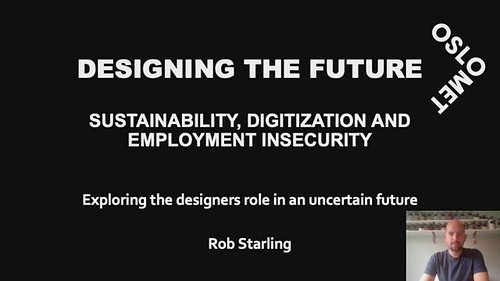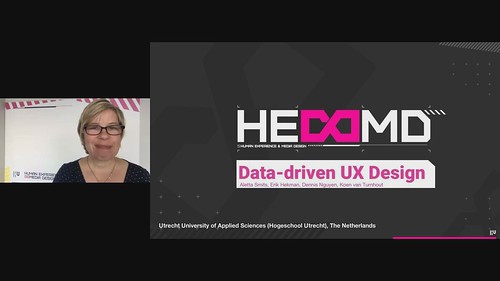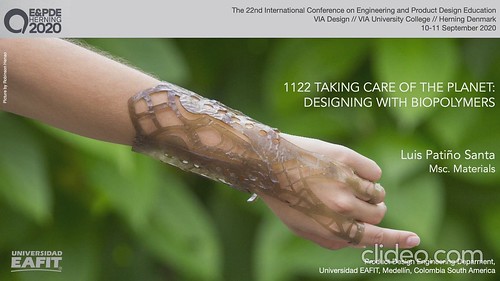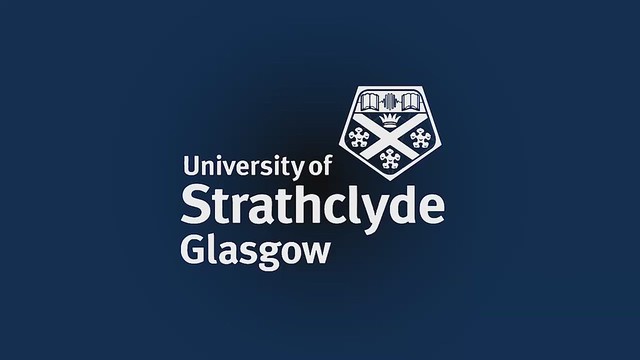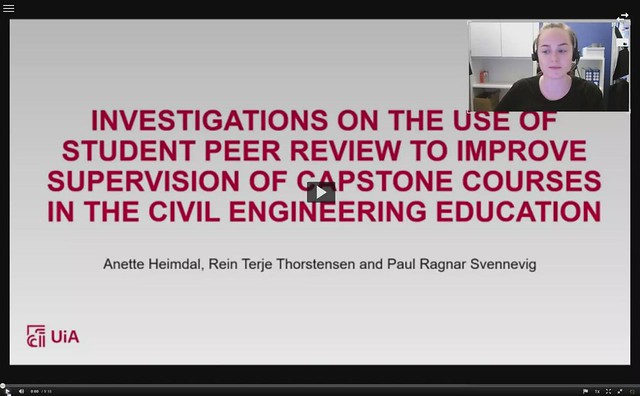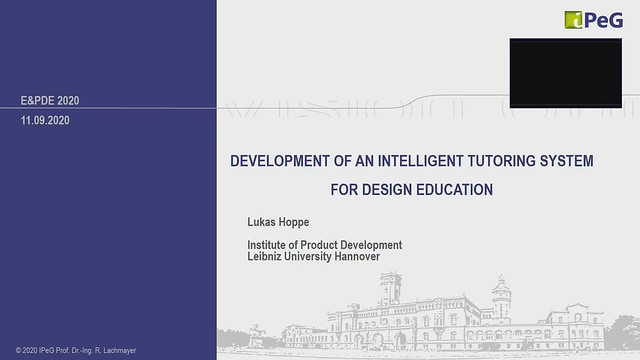Link to section
1A Educating Designers and Engineers for a Sustainable Future in Design and Engineering Education
1B: Addressing Ethical and Social Issues in Design Education
1C: Research in Design and Engineering Education Practice
1D: Meeting 21st Century Challenges in Further and Higher Education
Panel Discussion 1: Our Transition to Online Teaching and Learning
2B: Innovation and Creativity in Design and Engineering Education
2C: Research in Design and Engineering Education Practice
2D: Educating Designers and Engaging the Public
3B: Educating Designers and Engineers and Engaging the Public
3C: Research in Design and Engineering Education Practice
3D: Meeting 21st Century Challenges and Addressing Ethical and Social Issues
4B: Innovation and Creativity in Design and Engineering Education
4C: Research in Design and Engineering Education Practice
4D: Meeting 21st Century Challenges in Further and Higher Education
Panel Discussion 2: New didactical and pedagogical competencies
5A: Industrial Involvement in Design and Engineering Education
5B: Innovation and Creativity in Design and Engineering Education
5C: Industry 4.0 and the Implications for Design and Engineering Education
Workshops
Don’t Say it – Show it!
Emerging Sketching Technologies
Teaching Visual Courses Online
Greater Understanding of Consumer Behavior Through Neuroscience
Thursday, 10/Sept/2020
Welcome 1: Welcome – Day 1
Keynote 1: Maiken Hillerup Fogtmann from LEGO
Maiken Hillerup Fogtmann is a Senior Design Manager at LEGO® Education, an EdTech company that provides hands-on STEAM solutions for students and teachers by focusing on boosting student confidence through creativity, collaboration, and critical thinking.
1A: Educating Designers and Engineers for a Sustainable Future in Design and Engineering Education
DECODING SUSTAINABLE COMPETENCIES AND DIDACTICS IN DESIGN EDUCATION
Thomas Østergaard
VIA University College, Design, Denmark
doi: https://doi.org/10.35199/EPDE.2020.2
As recent reports and researchers suggest, the development of future ‘creativity’ and ‘creative skills’ of the future designers could be determinant for the designer’s capacity of dealing with the complex future challenges and the designers employability. (Future Skills Report, 2018 (FSR)Manzini, 2016, Wilson and Zamberlan, 2017)
As recent reports and researchers suggest, the development of future ‘creativity’ and ‘creative skills’ of the future designers could be determinant for the designer’s capacity of dealing with the complex future challenges and the designers employability. (Future Skills Report, 2018 (FSR)Manzini, 2016, Wilson and Zamberlan, 2017)
At the same time, researchers impose the role of the designers and design schools to be potential “Agents of Change” (Manzini, 2016) and a revaluation of creativity as a key factor in employability is also emerging within design-education and cognitive psychology research. (Cortinas, Esparza and Martinez-Villagrasa, (2018), Williams and Askland, 2012, Stana, 2017)
In a study, summarizing research and practices over three years in the “Decoding European Creative Skills” (DECS) program, Cortinas, Esparza and Martinez-Villagrasa, (2018) collected data by interviewing and performing action-research workshops with a product design SME professional and students from ELISAVA, Salzburg Hochschule and Delft University in a creative challenge set-up. They also used the newly developed EU-funded research project which is on-line the “Creative Decoding Tool” (CDT) (“The Creative Competencies Dictionary, Between Design Practice and Education in the 21’ st Century” (2018).
This paper wishes to analyze if a learning process, based on Service Design (SD) methodology, with a divergent and convergent approach of the Experimental Experience Learning and entrepreneurial didactics (Kirketerp, 2011, Kolb, 1984, 2005) can adapt some of the recommendations and recent DECS project, by increasing the focus of self-assessment, efficacy and reflection earlier in a learning design-process and how this knowledge can be used by students, the collaborating partners and the professors involved in the future complex design-projects.
The Challenges of Teaching Design in the 21st Century, the Age of the Fourth Industrial Revolution
Martin Sole, Patrick Barber & Dani Harmanto
University of Derby, United Kingdom
doi: https://doi.org/10.35199/EPDE.2020.4
There is an ever-growing demand from industry for qualified design engineers. Many of these design engineers are trained at universities and colleges. This paper will explore how to keep this training as up to date and relevant as possible. It will look at the modern techniques and methods used by world-leading industries during the 21st century. This century, known also as the Third Industrial Revolution, or the Information Technology Revolution. It will show how these techniques and methods can be applied in academia. A challenge is also highlighted, how to get students to design to industry standards but at the same time make it possible to assess their work to satisfy the needs of academia and awarding bodies. These modern techniques and methods will be applied to actual university students and an assessment made of the results. Use of group working will be explored and an algorithm developed to grade the completed group work. What do students need now to equip them to become competent designers, and what will they need in the near future?
ACTIVE LEARNING AND CRITICAL THINKING IN FASHION DESIGN EDUCATION
Mette Nørgaard Terkildsen & Malene Pilgaard Harsaae
VIA University College, Denmark
doi: https://doi.org/10.35199/EPDE.2020.69
Design for sustainability is not a new concept, it has, however, evolved from a single product to a complex system, which places design and engineering in the tension between consumption dynamics, product thinking and system thinking, accompanied by an increased need to understand user values to qualify, operate and integrate “ sustainable product strategies”.
This article presents a didactic approach to foster students’ ability to diverge between zooming out and zooming in as it enables exploratory, action-orientated, and transformative learning and encourages students to think critical and systematical. Zooming out relates to the context or the bigger picture. Through empirical research, students experience and establish what is going on as opposed to speculating on what might be going on. In this face, students discover patterns and map the territory, establish causes and effects before acting. Based on discovered patterns and mapped territory, they zoom in on details. Understanding details is like building blocks put together; they form solutions, settle arguments of relevance.
Technology is turning mass market into millions of niches; thus, designers, engineers, and manufacturers no longer have to target the big hits at the head of distribution. Instead, technology allows targeting individuality in the tail of the distribution. Transition towards a more sustainable fashion industry requires changes throughout the value chain and a paradigm shift in how we develop, produce, and consume products. Product design can be viewed as a single- dominant design discourse or as an inclusive and multiple oriented matter viewed in a holistic and transdisciplinary discourse. The first relates to one dominant value and practice that builds on ideal norms and linear processes, thus creating a dichotomy of either you Fit in, or you do not.
In contrast, multiple orientated discourse reflects products of multiple values viewing users, products, and processes in a bigger picture, exploring ways of understanding diversity, multiple perspectives, and practices. By adopting a transdisciplinary approach, we move instruction beyond merely blending disciplines. Rather we link concepts and skills in a real-world context and promote depth of understanding as well as adaptability of knowledge needed to create inclusive product design and engineering.
We argue that one insightful lens of discovering sustainable product strategies derive from reality itself taking an active part in understanding cause, context, and values. Combining field research, empathy, and technology (learning, thinking, acting) establishes a strong foundation for sustainable and inclusive product design. In this understanding, field observation is not just about describing what we see; it about proposing what is missing. Thus, it can be argued that it is prospective but grounded in a profound understanding of context. For students to understand the working of the principle, how to vary its operations, knowing how to provides value of the individual customer, enables students to access knowledge of what is significant, how it fit in to the larger scheme of things (relation to surroundings and Fashion in general) thereby understanding the main determinants of consumer-product attachment as one approach to sustainability promoting responsible, durable, viable and desirable product design.
A qualitative study of the challenges faced by material designers when developing DIY-materials
Charlotte Asbjørn Sörensen & Emma Thyni
Malmö University, Sweden
doi: https://doi.org/10.35199/EPDE.2020.76
The recent academic literature on material practices within design has revealed the emergence of a new design discipline, DIY-materials (Mariani, Rampino 2019, Rognoli, Bianchini et al. 2015, Rognoli, Ayala Garcia 2018). Designers educated in DIY-materials (Rognoli, Ayala Garcia 2017) and the Material Driven Design method (Karana, Barati et al. 2015), applied in design courses in major European universities, e.g. Politecnico di Milano (IT), Malmö University (SE), University of Gävle (SE), and Imperial College London are beginning to identify themselves as material designers.
However, these designers and students are facing great challenges when trying to develop DIY-materials with promising experiential qualities and technical properties (XXXX, 2018) into viable materials. This paper presents a qualitative case study of the challenges faced by material designers and design students developing DIY-materials from the stage of an aesthetically pleasing small sample towards a more viable material. A comparative case study (Gibbs 2008) of thirteen material driven design projects and four explorative semi-structured interviews were conducted with designers. The result suggest: (a) that designers have a tendency to focus more on the experiential attributes and aesthetical qualities rather than the technical attributes in the early stages of material development, (b) projects that are situated in specific contexts or systems have a higher success rate, (c) most bio-based DIY-materials are sensitive to moist and high temperatures, (d) a systematic approach during tinkering combined with analytic skills are crucial for the development of DIY-materials. In this paper, we also build on our previous research, regarding the development of reflective material practices for design students in higher education. It is hoped that this research can contribute to the further development of material design as a new design discipline.
EXPLORATORY RESEARCH TO BETTER UNDERSTAND THE DIFFICULTIES OF TAKING SUSTAINABILITY INTO ACCOUNT IN THE EVOLUTION OF ENGINEERING EDUCATION AND TRAINING
Lou Grimal, Jules Baudry, Pelgrim Charraud, Rémi Céret, Nadège Troussier
Université de Technologie de Troyes, France
do: https://doi.org/10.35199/EPDE.2020.34
Humanity’s entrance into the Anthropocene forces us to question the role of technology because of its impacts on the environment. The stake is the viability of the Earth system for humans. Engineers producing a large part of these impacting techniques are not trained in sustainable issues (environmental, social and economic ones – in a systemic way). An exploratory workshop was held at a French University of Technology to study the development of new engineering training courses on issues of strong sustainability. During this workshop, the participants were placed into the current French institutional framework and were asked to develop a new training within this specific framework. The hypothesis formulated at the end of this experiment is that institutional frameworks can be an obstacle to the production of new training adapted to the transition phenomenon to respond to the increasing risk of socio-ecological catastrophes. This experiment was conducted as part of a heuristic approach and opens up new perspectives for the evolution of training as well as institutional frameworks in higher education and research.
1B: Addressing Ethical and Social Issues in Design Education
USING CERAMIC CRAFTS TO TEACH USER CENTRED DESIGN FOR WATER PURIFICATION AND DEVELOPMENT
Richard Harlow, Lyndon Buck
Bucks New University, United Kingdom
doi: https://doi.org/10.35199/EPDE.2020.78
<Video not available>
The development of more advanced technologies for manufacture and knowledge exchange has opened up the world to wider trade and partnerships, requiring designers to consider the suitability of their products for cultures other than their own. With these advances a student’s ability to access other cultures has also increased, allowing them to research a cultures practices and traditions in greater detail. However, the availability certain technologies differs from country to country, with many developing countries having stable access to technologies like mobile telephones, while still lacking basic access to clean drinking water. The use of design for development briefs give students the opportunity to practice user centred design, life cycle thinking, cultural perspectives and appropriate material processes. This paper explores the work produced by level five product design students completing their ceramics practice module. In this project they followed a brief inspired by the authors’ work in the EU Horizon 2020 funded WATERSPOUTT project. The WATERSPOUTT project has worked to provide solar disinfection (SoDis) resources for the disinfection of local water for target communities in Uganda, South Africa, Ethiopia and Malawi. The authors’ role in the project was primarily to design a ceramic filter to be used in combination with Solar disinfection technologies.
The students were asked to design a water filter and water storage vessel for a country of their choice, inspired by the pottery styles of that culture. To complete this task, it was necessary for the students to select a developing region, locate the relevant information to identify key design features of the cultural heritage, and creatively apply them to a household water purification system. Conventionally the inclusion of ceramics on a design course centres around the production of household utensils or sculptural pieces, often with the intention of exploring the form of the object. This task was formulated to create opportunities for the students to consider their users’ needs and environment to produce functional and sustainable designs. Students used a mixture of traditional and modern production methods ranging from coiling, press moulding and 3D printing to produce their water storage vessels. Filters were produced using the method suggested by Potters for Peace, using a combination of sawdust (harvested from the furniture workshop) and powdered terracotta clay (other clay types were provided, though terracotta best suited the cultural demographics of the students’ selected countries).
This paper will inform educators on the inclusion of design for development within a module and reflect on the module’s outcomes identifying its successes and areas for future experimentation. While technology advances there is a risk of over dependence on the more modern CAD and CAM systems reducing student’s familiarity with materials and processes. To reduce this dependence students can benefit from learning a range of modern and traditional techniques, finding where each can complement the other. Additionally, students can explore the value of products in contexts outside of commercial product development, considering a wider scope of product implementation and knowledge exchange.
Cultivating Responsible Design with the Product Impact Tool
Wouter Eggink
University of Twente, The Netherlands
doi: https://doi.org/10.35199/EPDE.2020.3
Industrial Design Engineers have social responsibility by the very nature of their activities; bringing new products and services into the world of the user. Recently there is also raising interest in specifically addressing social issues by deliberate design interventions. One can think of health related issues like obesity or the raising costs of healthcare. How can we design products that encourage people to do more exercises? Or to consume less? How should a robot system that supports people with dementia behave? And what does this mean for the existing care-givers? And how should we as designers deal with unforeseen outcomes or unwanted side-effects of our design interventions?
Within the design related research chairs of our university we strive to shape this responsibility in the context of the design of Human Technology Relations. At this time we discern three different perspectives on the implementation and consequences of this social responsibility for design theory and practice;
- Designing in such a way that the outcome (product or service) encompasses social responsibility. This is done by investigating or exploring the impact of products in society and social context.
- Designing in a social responsible manner by organizing the design process in a responsible way. This means that all stakeholders have their part to say in the development of new products or technologies.
- Designing in such a way that the responsibility of the user is addressed in or with the product. This strand is represented by the idea of Open Script Design, in which responsibility is shared between the designer and the user, by leaving the exact use of the product (more) open to interpretation.
This paper will report on the experiences with teaching the first type of responsible design in the context of an Industrial Design Engineering Master course “Create the Future”. In this course student groups explore the future of a specific design domain by means of future scenario development. In the course, the potential impacts of future design interventions are actively explored by means of the Product Impact Tool. The Product Impact Tool is a framework, derived from Philosophy of Technology and User Centered design that addresses the multitude of impact types that technologies have on humans and human behaviour. This tool is seen as particularly of interest for evaluating future technological developments.
The paper will describe the approach of the Product Impact Tool, the implementation in the course and the outcomes of the students analyses. After that, it will look at the influence of the Product Impact Tool exercise on the design results of the course. From there it will discuss the value of the method for the implementation of responsible design in design education.
Fostering design literacy, empathy and awareness in codesign
Tim Ball, Paul Magee, Andree Woodcock, Deana McDonagh, Sinead Ouillon, Louise Moody, Felipe Moreira, Kat Gut
Coventry University, United Kingdom
doi: https://doi.org/10.35199/EPDE.2020.18
<Video not available>
Using low fidelity simulations, the authors have previously introduced elements to an undergraduate product design module, to improve empathic forethought among student designers, designing with and for elders. Student feedback suggested a willingness and enthusiasm to adopt more empathic approaches to design problems and an understanding of the responsibility that resides in their hands. They also suggested that training could be enriched by engaging with elders during concept development and prototyping. In codesign, citizens may be asked to inform, constrain and evaluate product development to meet ‘their’ needs or those of their peers. It is often these insights which provide a basis for innovation around which designers can instill value, desire, benefit and affect perceptions of stigmatizing issues. Using a real-world scenario, students followed empathic, experiential exercises before engaging with elders.
Mindful of the need for such interactions to be enjoyable, fruitful, reliable and valid for both students and participants, this study focused on the interaction between students and elders during concept development and final presentation. Six groups (32 students in total) were observed interacting with 12 elder citizens. Data was gathered from students’ reflections, observations of tutors, and focus groups with elder citizens. From this, we have developed guidelines to ensure that both citizens and students derive maximum benefit and enjoyment from these activities.
Designing the Future – Sustainability, Digitisation and Employment Insecurity
Robert Starling
OsloMet, Norway
doi: https://doi.org/10.35199/EPDE.2020.36
Technology is changing the world. Automation threatens to make large numbers of people unemployable in the near future, digitisation alienates older generations and globalisation has connected the world. The way that we interact with technology and deal with its consequences will impact individuals, companies, governments and the future of humanity. How do we prepare for unpredictable future scenarios, and what role do designers have in this transition? Through research and interviews with experts from the tech industry, representatives in Oslo city council and NAV (Norway’s public welfare agency), future opportunities are explored. Designers and institutions can utilize sustainable, human-centred, service, and systems-oriented design methods to develop solutions to problems at different societal levels. If we are to succeed in creating a sustainable future for humanity there will need to be a lot of change, and quickly. Fortunately, we are learning faster than ever before, becoming increasingly aware of the problems, share a common goal, and have access to the tools and methods that can change the systems that we live in.
THE IMPORTANCE AND RELEVANCE OF INCORPORATING ETHICS AS PART OF ENGINEERING EDUCATION – A POSITION PAPER
Anders Folkman, Rein Terje Thorstensen, Varg Lukas Folkman
University of Agder, Norway
doi: https://doi.org/10.35199/EPDE.2020.50
<Video not available>
Civil engineers make ethical decisions; in business behavior, when advising clients, in execution of works, and on environmental issues. Making the “right choice” often conflicts with economic interests. However, consciousness in valuations increase quality of decisions and might improve value of both individuals and corporations in the longer run.
Engineers are often in powerful positions, able to influence society substantially – also as role models for others. Hence, ethics should be considered an obvious part of all engineering education, as important as any other part of the education program.
All people have a sense of right and wrong. It is important to nurture and develop that sense to educate young professionals equipped with ethical ballast, making them able to identify situations where their ethical judgments are called for – and to (re-)act responsibly.
It is not obvious how the education programs should incorporate ethical issues, to nurture and develop awareness and response reflexes. For traditional university educations, ethics is often given as an independent introductory subject. This is not always the case for engineering education, and it might not necessarily be the best strategy.
This article investigates alternative strategies for incorporating ethical awareness and training, as part of a Civil engineering education program. The investigation is executed related to an ongoing revision of an actual program. Conclusions from the investigation will be implemented in the education, at a minimum through the lecturing practice of the involved researchers. It is our intention to follow up by evaluating effects over time, through surveys and further assessments.
1C: Research in Design and Engineering Education Practice
Data-driven design
Aletta Smits, Koen Van Turnhout, Erik Hekman, Dennis Nguyen
Hogeschool Utrecht, The Netherlands
doi: https://doi.org/10.35199/EPDE.2020.10
The datafication of society has an undeniable impact on many design professions. More and more designers are asked to research, imagine and prototype systems and services in which data and machine intelligence play a vital role. One could say that data and computer intelligence are the design materials of the future. How should we prepare the new generation of design professionals to handle the challenges and opportunities associated with design in a data driven world?
In this paper we present our approach to this challenge as we have implemented it in the master Data-driven design of our university. Central in the program is the notion of products that get better, simply because they are being used. We call this the data driven design feedback loop. It describes the user experience as a continuing interaction between user behavior, machine intelligence and business objectives.
Our program consistently provides tools to students, so they can find ways to incorporate such a feedback loop in products, stories, campaigns that they develop. That comes with ethical questions that range from various biases (age, gender, background, etc.), to philosophical questions on how society is shaped by data in general and data-driven feedback loops in particular. The graduation part of the course consists of writing a short paper on a data-driven concept that the students have designed themselves and building a prototype that actually explores the concept and the theoretical framework that drives it.
In this paper we give an outline of the program, and discuss several examples of design cases in which the data driven design loop was used. We also discuss the challenges we encountered to help student think in a ‘data-driven-way’. We, therefore, conclude the paper with recommendations for preparing design students to design with data and machine intelligence.
USER-CENTRED DESIGN FOR A NOT STRAIGHTFORWARD UNIVERSITY WAYFINDING
Javier Poves Picazo, Amber Hazenoot, Celia Martínez Otaduy, Marie Braux, Way Kiat Bong
Oslo Metropolitan University, Norway
doi: https://doi.org/10.35199/EPDE.2020.11
OsloMet – Oslo Metropolitan University gets a big number of new students and visitors annually. The main campus of this university consists of many different buildings, where different faculties, libraries and other services can be found. For this reason, students and staffs need to navigate around from one building to another. Visitors who are attending meetings, conferences and other events, need to find their way around the campus. Unfortunately, navigating around the campus can be challenging, as the existing wayfinding system is complex and not straightforward. This paper presents a problem-based approach to address the wayfinding challenges around the campus. Four European Project Semester (EPS) students approached this project as a user-centered design study. By using user-centered design approach, we involved the end users throughout the whole study. First, interviews and field research around the campus were conducted to identify the underlying problems. The findings indicate that the main problem is the inconsistent numbering system for rooms. On top of that, the signage systems were not clear, visible and coherent for all different buildings in the campus. The proposed solutions include therefore, a new consistent room numbering system which can be applied to all buildings, and a signage system that was developed based on the room numbering system. In addition, a featured navigation app that complemented the numbering and signage system, was designed. Together with graphic design principles and wayfinding guideline, the use of user-centered design guided the process of designing and developing the proposed solutions. Scenario-based user testing was conducted with the university students, with the aim to gather end users’ feedback and responds to the changes made to the prototype. The participants were observed while performing testing tasks. It was then followed by interview after the testing. The final user testing shows that the new wayfinding system is clear, standardized and can be applicable for all buildings. The participants performing the user testing, commented that it was more efficient and easier to navigate around with the new numbering and signage system. Shorter time in navigating to the appointed room was observed and no mistake was made. The app was found out to be a useful and helpful feature for wayfinding. We reflect upon that adopting user-centered design approach could contribute to designing product that meets the requirements of the end users. As a group of EPS student, we learned to involve end users and stakeholders while managing and delivering the proposed wayfinding solutions. Semi-structured interview and scenario-based user testing contributed in large extend in identifying the problems in the current wayfinding and user requirements for the proposed solutions. Interviewing people was new to the group and it was crucial to ask questions that able to prompt the interviewees’ feedback and gain as much insights as possible. While generalizing their feedbacks, we applied graphic design principles and wayfinding guideline. To conclude this paper, we would like to highlight the importance of involving users throughout the whole research process, which also reflects our most significant learning experience as a group.
Exploring socially shared regulated learning in PBL using group digital learning diaries: A study design
Thea Morgan
University of Bristol, United Kingdom
doi: https://doi.org/10.35199/EPDE.2020.14
<Video not available>
With the rapid pace of technological innovation, students of engineering disciplines must develop skills as lifelong learners, in order to keep up with the ‘explosive growth of knowledge and skills in their career and to retool into a new career after their previous one runs its course’ (Nilson, 2013). The future of engineering education therefore centres on active learning in authentic contexts (Graham, 2018). Creating learning environments in which students take control of their own learning, construct and co-construct new knowledge and skills for themselves in relation to ‘real-world’ complex subject matter, and are able to transfer what they have learned to new problems and settings (Wallin & Adawi, 2018). Active learning is underpinned by self-regulated learning (SRL) skills, such as; assessing the demands of a task, setting goals for learning, selecting suitable resources, selecting suitable methods for learning, and evaluating progress (Pintrich & Zusho, 2007). These skills relate to the metacognitive, behavioural, and motivational aspects of learning (Panadero, 2017). Teaching and learning approaches which support the development of SRL skills are student-centred and focus on formative assessment, sense-making, and reflection. Approaches such as project-based-learning.
Whilst many studies have considered SRL processes at an individual level (Panadero, 2017), the role of SRL during collaborative learning remains unclear. There has been little research into socially shared regulated learning (SSRL), despite common agreement in the field that it is needed (Hadwin et al., 2011). It is the aim of this research to investigate ways in which to capture, formatively assess, and develop SSRL skills, during student-centred engineering design learning in collaborative learning spaces, using group digital learning diaries. Learning diaries are shown to be an effective method for capturing SRL processes, as well as formatively assessing them (Wallin & Adawi, 2018). They have also been shown to facilitate the further development of students’ SRL skills (Babapour et al., 2012). The digital nature of the diaries is intended to better facilitate group entries, through use of large touch-screen tablets, and make it possible for students to record information in a variety of formats. The study explores three central aspects of SSRL: conceptions of knowledge, conceptions of learning, and strategies for monitoring and regulating learning (Wallin & Adawi, 2018)
A prototype group digital learning diary has been developed, and is currently being trialled within a Y2 undergraduate engineering design methods course at the University of Bristol. The course uses a student-centred group project-based-learning approach. The structured diary design, including reflective questions and prompts, is based on that developed by Wallin, Adawi & Gold (2016). At the end of the course focus groups will be conducted with the student groups, forming an additional dataset to the diaries. The two primary data sets will be inductively analysed using a qualitative thematic analysis approach (Braun et al., 2019). The prototype diary will be further developed in response to initial findings, and trialled again in the next presentation of the course. This paper reports on the research justification, study design and progress to date.
NEW INSIGHTS ON INDUSTRY DEVELOPMENT PROCESSES THROUGH ENGINEERING DESIGN STUDENTS’ ANALYSIS
Marc Nutzmann, Markus Voß, Thorsten Sauer, Hulusi Bozkurt, Tobias BÖHNLEIN
Cooperative State University Mannheim, Germany
do: https://doi.org/10.35199/EPDE.2020.21
<Video not available>
At the DHBW Cooperative State University engineering design students are encountered with a course on systematic approaches and processes (e.g. time to market process, integrated engineering processes), methods of several kinds to facilitate and strengthen efficiency in design and development.
Traditional process models as described in the VDI2221, a standard by the German Institution of Engineers, or the stage-gate system by Cooper are well known and applied in many engineering companies. Other models such as integrated engineering, agile project management and design thinking have been developed in order to find more efficient and effective approaches. Their grade of application in industry, especially mechanical engineering is rising – often beginning in pilot projects. The influence of these and other approaches is reflected in this paper and suggestions for educational concepts are derived.
A study has been carried out in five Bachelor courses and a Master course, in which altogether 180 students were enrolled. The study evaluates among the students which education concept helps to broaden systematic and methodical approaches best, which process models are found to be applied in industry, thus applied in the student’s own company. The latter point can be analysed as every student at the DHBW cooperative university has a contract with a company and spends half of the studies in the company, spending more or less alternating three months at university and three months in the company per semester. This allows insights into a high number of companies of different branches and sizes (approx. 120), contributing to this study on finding important insights in design and development processes in the companies.
Suggestions and examples for education in engineering design processes are derived from latest findings and developments, industrial, educational, sustainable and social influences but also recent research papers. A broader learning of engineering processes, transfer of knowledge concerning alternative processes and socio-cultural aspects are suggested.
Do differences in educational culture affect the process and outcome of undergraduate design practice?
Ceri Almrott1, Colm O’Kane1, Robert Tully1, Lyndon Buck2
1Technological University Dublin, Ireland
2Buckinghamshire New University, UK
do: https://doi.org/10.35199/EPDE.2020.20
Designers acknowledge that global organisations can have different ethoses and cultures which affect the way that they undertake the process of design and the products that they develop[1]. It is also understood that different social cultures have and use value sets in different ways[2]. It is suggested by Branda, Silveira et al that the way we educate students affects the way in which they form design briefs and we can suppose that this also applies to other parts of design practice[3]. Together, these observations raise questions around the methods used to educate designers. Alternative approaches suggest themselves. Students’ tuition could be tailored to user preferences in their specific regions; or global practices could be incorporated into all pedagogies, regardless of location.
This paper outlines a pilot study in which design practice across different institutions is analysed and assessed through ethnographic research processes and follow up interviews with students working on similar design briefs. By investigating the design processes deployed by individual students it is intended that the following research questions will be answered:
Is there commonality in the themes and influences during the research phase of a design project? How do students define their design problem? What tools and approaches do students use to conceptualise and develop their ideas? What approaches do students undertake to deliver their design concepts?
The main process for gathering data will be through cultural probe style ethnographic research intended to investigate and understand design practice as it is being undertaken. The probe has been designed by the authors following on work at ISD Rubika[4] to allow students to record and interrogate their design process. The results of the probe will then form the basis of one on one interviews of the students.
The research acts as a pilot study for a piece of cross disciplinary doctoral research which aims to investigate the role of globalisation on the practice and outcome of designers around the world. A similar process will be incorporated across a much larger cohort of practising designers.
1D: Meeting 21st Century Challenges in Further and Higher Education
FOSTERING A LEARNING EXPERIENCE THAT IMPROVES KNOWLEDGE EXCHANGE BETWEEN ACADEMIA AND INDUSTRY
Laura Filippa Ferrarello
Royal College of Art, UK
do: https://doi.org/10.35199/EPDE.2020.39
The future of our society is an idiosyncratic process which is constructed through the contribution of different parties across different sectors and disciples, of which education is one. This, in particular, requires a particular attention for its role in developing future generations’ skills and knowledge through methods and approaches that impact the way people learn and construct knowledge.
Under the transformations of advanced technologies like AI and robotics education needs to rethink what is and how it takes shape learning; it also needs to redefine its boundaries, i.e. if education is something confined to a particular stage of life or if it can extend to one’s life experiences. These are two of the key guidelines that the MRes refers to to develop postgraduate education that encompasses the STEAM (Science, Technology, Art/Design, Mathematics) disciplines and provides methods that accounts for creative, critical and unilinear thinking, ethical practice and interdisciplinarity, all developed through cross-discipline collaborations. Zooming in particular on the Design Pathway it will be described how the curriculum constructs a journey that equally supports the advancements of technical skills, e.g. robotics, coding, advanced manufacturing techniques, etc., and interdisciplinary collaboration based on design research methods. This is to foster the exchange of knowledge across disciplines and expertise and stimulate peer learning. The motivation is not only to proactively inform the future of work through the lenses of education, but also to construct inclusive innovation that is grounded in society and responds to its needs under the lenses of its beneficiaries. Through a combination of workshops, seminars, personal and group tutorials, it will be described how the MRes Design framework provides the space to reflect individually and collaboratively through personal research and group projects. These activities will describe how the exchange of existing knowledge and experience is core to inform new platforms of education and professional work – euqually spanning through design and engineering, that prepare students and future professionals to tackle future social challenges. Under the term of this contribution education is not a confined event that frames one particular stage of life but an experience “in transit” that encompass the student’s past and present knowledge to develop and build STEAM cross-discipline practice and theory based methods and methodologies based on design methods. This is to empower current and future workforce who, by transiting through design research education and methods (action, participatory research, future forecasting, ethnography, etc.), is able to creatively approach present and future challenges a d develop new methods and approaches through the exchange of knowledge and experience.
AN ACTIVE LEARNING APPROACH FOR A DESIGN THINKING COURSE
Francesca Mattioli & Lucia Rampino
Politecnico di Milano, Italy
doi: https://doi.org/10.35199/EPDE.2020.49
Design research has always tried to shed light on the way designers think, opening a variety of discourses on this topic, both in the professional and in the academic fields. On the other side, in Politecnico di Milano design students are exposed to “learning by doing” design studio courses, where they are required to acquire the skills and competencies needed to think and act as a professional designer through action.
Current design practice, the one we teach to students, is the result of a century of disciplinary developments, deeply influenced by societal and technological changes. Even though students become aware of such changes in design history courses, it is sometimes hard for them to link the practical knowledge acquired in design studio courses with the theoretical one. As a result, students may attain practical design skills without critically reflecting on the reasons why the designers’ way of thinking and acting evolved in that specific way. For example, in recent years, designers had to embrace two digital revolutions: first the advent of web 2.0 and then the availability of digital fabrication technologies. These two revolutions are having a huge impact on our societies, from several points of view. Similarly, given the increase of social and environmental awareness, designers must today face the responsibility of the ethical end environmental implications of their professional practice.
In our view, a deeper understanding of all the societal and technological changes that happened since the rise of the design discipline is fundamental to better understand today established designers’ way of thinking. Moreover, we strongly believe that a student able to critically link the current state of design profession to the historical facts that brought design to its current state will be also able to get a deeper understanding of future societal and technological challenges. Addressing the conference theme, “The Value of Design & Engineering Education in a Knowledge Age”, this paper will provide insights on a possible approach to help students cultivating their critical thinking. As a result, they will be better prepared for the fast changes of the design profession.
The paper presents the case of the course “Design Thinking and Processes”, part of the curriculum of the Design and Engineering MSc of Politecnico di Milano. The course aims at stimulating critical reflection through the understanding of how design has evolved from its birth to nowadays, going through four perspectives: technical, human, digital and social. To reach such aim, the course heavily adopts active learning through seminars, flipped classrooms and group discussions.
After three years of experimentation and refinement, the course appears to be coherently designed in terms of intended learning outcomes, assessment strategy, activities and contents. All this is illustrated in the paper. The overall course has been assessed by students throughout the first semester of the current academic year. The paper aims at discussing the results of this assessment.
In general, the paper offers to teachers and scholars an example of an active-learning approach to support students’ learning about the way designers think.
EVOLUTIONS IN INTER-YEAR TEAM WORKING: A LONG-TERM CROSS-SECTIONAL VIEW
Clare Green
ISD Rubika, Valenciennes, France & EHESS, Ecole des Hautes Etudes en Sciences Sociales, Paris, France
do: https://doi.org/10.35199/EPDE.2020.64
Despite continuous evolutions in both design methodology and the scope of design practice, team-working remains a core feature in much design activity. As design methodology expands beyond traditional design practice contexts, designers’ ability to work in complex multi-disciplinary teams and collaborative environments is ever more relevant. The higher education context may not fully replicate diversity encountered in the design workplace, but can give students concrete experience of heterogeneous team-working.
This paper re-evaluates a series of inter-year team project modules introducing students to advantages and difficulties involved in collaborative working. The projects studied involve students from different year groups in teams of four to six, repeated four times in the course of years three to five of masters design courses. In this series of project-based modules, students go from being junior team members in their third year, working with year five and then with year four students, to being team leaders in their fourth and then fifth year of study. During these projects students progressively build upon previous team-working and collaborative experience.
Carried out from 2010 to 2013, previous research explored how past teamwork experiences influence future team behaviour and what learning is reapplied. Research also highlighted aspects of experiential and peer-learning most clearly identified by the student cohort. This enabled the school to identify difficulties and moderating factors in these projects, and address certain issues in order to improve both the modules and advice given to students.
Nearly ten years later, this article presents new research based partly on the same protocols to give insights on evolutions on a number of levels. This research is based on student retrospective feedback, in the form of written reports, on their individual journeys through 4 consecutive inter-year team projects. Contemporary project evaluations by teachers and interviews with teaching staff on individual student journeys complete the research, giving complementary viewpoints on projects and student experience.
Past research gave insights into positive reported impacts on personal student evolution and better understanding of good teamwork and good team-management practice. Common points in positive student journeys were remarkable experiences that lead to (self) reflection, an understanding of the difficulties of team management, shared ownership of team projects and an ongoing learning mindset. Identified difficulties were social-loafing/low motivation, non-constructive hierarchies, emotional intelligence/empathy issues, balancing socialising and external project partner influence were identified. While certain points from this research have been addressed in evolutions in the project format and teaching, new research gives insights into which of these issues remain relevant today, which may still need to be addressed and also what new issues appear for the current generation of student designers in relation to team working.
Above all this research, into modules that constitutes the backbone of design project experience during the masters design course, is an opportunity to question both the project format and emerging themes such as failure avoidance, gender related issues, increasing diversity within the student cohort and (environmental/ethical) responsibility.
HOW CAN COMMUNICATION LITERACY REINFORCE HOLISTIC DESIGN PRACTICES?
Nadiya Karibayeva & Tore Gulden
Oslo Metropolitan University, Norway
doi: https://doi.org/10.35199/EPDE.2020.77
The article explores how the knowledge of communication theory can help design practitioners to achieve a more critical understanding of the contexts they encounter in the course of their professional careers and lifelong learning paths. It is discussed how certain concepts of communication studies may benefit both interpersonal interactions and the design process itself. Autoethnographic research is used to reflect on the group dynamics and performance of 5 product design students during a practical training period in the area boost programme in Grorud district of Oslo. The different roles and behavioural patterns of the group members, such as domination and withdrawal, as well as the degree of engagement in discussions, consistency in communication, the impact of self-concept and cognitive biases are analysed against the background of cybernetic theory, Bateson’s communication theory, as well as Schön’s theory of reflective practice. The ways in which the group dynamics could be altered to facilitate more holistic approaches are suggested based on the findings obtained. By letting go of one’s roles and habits, accepting contradictions and opening up for questioning despite the uncertainty and threats it may pose for the comfort of stability, conditions can be created for more inclusive, engaging design processes, knowledge-sharing and, most importantly, learning through reflection. It is argued that communication literacy is one of the skills that form the basis for comprehensive and innovative design methodologies. Understanding communication phenomenon and different levels and types of communication, along with the ways it can be used to facilitate learning, i.e. change, have the potential to offer a new perspective on the wicked problems in design fields and should, thus, be included in the corresponding curricula.
THE USE OF ENGLISH AS LINGUA FRANCA IN CROSS-CULTURAL CLASSES: A CASE STUDY IN DESIGN AND ENGINEERING EDUCATION
Silvia Deborah Ferraris & Francesca Mattioli
Politecnico di Milano, Italy
doi: https://doi.org/10.35199/EPDE.2020.62
The increasing mobility of students is shaping a new higher education landscape, which is characterised by a higher number of cross-cultural courses and, consequently, a relevant ratio of international classes. In these learning environments, students are exposed to cultural diversity and, if supported in this sense, they learn to have an open-minded attitude to other cultures. This approach is aimed at developing a curriculum better suited for the growing global job market.
On the other hand, since students are not anymore native speakers, the language used in the learning environment becomes a relevant issue. The use of English as lingua franca is often the choice to address the linguistic diversity, both in English speaking and non-English speaking countries.
However, learning and teaching in English is not always an easy task for non-native speakers. Due to language gaps, some contents are sometimes not fully communicated or even missed. For these reasons the paper presents some reflections on the impact of teaching using English as lingua franca in cross-cultural classes, highlighting challenges and possible improvements.
In this regard, the case study of the master course in Design and Engineering of a, European Polytechnic is presented.
The course passed through a 5 years process of internationalisation, which brought to the switch from Italian to English. This process is evaluated with a mixed approach, interplaying qualitative data collected through questionnaires (to students and professors) and quantitative data collected every year by the Polytechnic. The intention of the authors is to assess the relation between the way students are evaluated through their study path in the master (i.e. from admission score to graduation score, in studio-based courses and theoretical courses) and to highlight possible connections with their knowledge of English language. The discussion presents trends that emerge from this analysis and from the comparison of qualitative and quantitative data.
This research proposes to point out the advantages and disadvantages of the transition from the native language to English in Design and Engineering higher education courses. Following the assumption that the use of English as lingua franca is the easiest way to implement cross-cultural education curricula, the authors look for some improvements that could be done to enhance the communication process between all the stakeholders (i.e. students, professors).
Panel Discussion 1: Our Transition to Online Teaching and Learning
Session Chair: Ross Brisco, University of Strathclyde
The panelists are:
Robert Starling, Oslomet, Norway
Francesca Mattioli, Politecnico di Milano
Mauricio Novoa, Western Sydney University
We wish to discuss the 2020 theme in the light of the pandemic crisis that have forced us to move the conference to an online platform.
2A: Visual Papers 1
EXPLORING “NU-EMPATHY” IN DESIGN EDUCATION
M. Ruth Robinson1, Bryan F. Howell1, Cameron Unson1, Hannah Lutz2
1Brigham Young University, United States of America
2Independent, United States of America
Visual paper – the real abstract is drawn, below is a verbal explanation of the paper.
<Video not available>
Human Centered Design asks us to use empathy to connect to those who we are designing for as a means to make the products we design more meaningful. A typical process that the industry uses is personas. This design philosophy is a commentary on the disconnect that can happen with that process. The lack of emotion that can be conveyed in the final product which in turn creates no bond between the user and the product. This is a consideration of a new process centered around my philosophy Design for Nurture or Nu-Empathy. The approach starts with the understanding of basic emotions and neuroscience on how the brain reacts to information to form new ways of understanding data and applying it in our field. The method used, to take Robert Plutchik’s Wheel of Emotion and evaluate the Nike Dream Crazier advertisement to understand the emotional communication underlying the message. This data can help educate students by asking them to approach their design process in a new way.
ASSESSING FIGURES OF SPEECH AS A CREATIVITY TOOL FOR DESIGNERS
Bryan F. Howell1, Carly A. Matheson1, Kody Partridge2
1Brigham Young University, United States of America;
2Rowland Hall
<Video not available>
Design in Context
Richard Anthony Elaver
Appalachian State University, United States of America
URL: https://designsketching.designsociety.org/40/DESIGN+IN+CONTEXT
This visual paper is intended to depict the broader context of Industrial Design for use in the education of designers and non-designers. Instead of a focused dive into a single aspect of our field, the goal is to take a macro view of the many facets that interact and influence our work. Product design is usually one contributing part of a multi-disciplinary team in the development, production, marketing, and distribution of a product. Moreover, the practice of this profession is inherently intertwined in the international systems of material sourcing and production, industrial manufacturing, shipping and logistics, promotion & sales, consumption/use, and disposal/repurposing. In the process of designing products, we consider ethnographic research, psychology, physiology, and social identity, regarding potential users and their cultural contexts. And it is during the design stage that critical decisions are made about the life cycle and environmental impact of the products and systems of production. Using a toaster as a product protagonist, and considering key concepts from multiple texts, this paper will visualize the complexity of this multi-faceted context into a single, multi-page graphic.
A NEW LANGUAGE FOR SKETCHING THE INTANGIBLE; BUILDING ON A MUTUAL FUNDAMENT
M. Sypesteyn, J.W. Hoftijzer
Delft University of Technology, The Netherlands
<Video not available>
2B: Innovation and Creativity in Design and Engineering Education
STEM COMPETENCY-BASED LEARNING FOR ENGINEERING AND DESIGN STUDENTS OF THE EDUCATIONAL MODEL TEC21
Carlos Alberto Gonzalez Almaguer1, Mariana Maya López1, Alejandro Acuña López1, Eduardo Caballero Montes2, Claudia Zubieta Ramírez3, María Consuelo Yarto Wong3
Tecnológico de Monterrey, México
doi: https://doi.org/10.35199/EPDE.2020.25
The new educational model at Tecnologico de Monterrey, known as Tec21 and based on competencies, has left behind the educational model based on objectives. As part of its pedagogical support, the new model has considered two kind of competencies: the transversal competencies such as collaboration, problem solution, ethical analysis, leadership, innovation & critical thinking; and the disciplinaries competencies, for example, statistics, quality control, design of experiments, inventory control, planning, forecasting, for mention some academic areas. Competency-based learning curricular design in this educational model is necessary to transfer knowledge to students thru academic activities schemed specially for it. In the Industrial Engineering and Design teamwork, we are using the play lab concepts to build academic activities with interactivity between the academic and the industry ecosystem.
To design activities that represent a challenge for the students, designer teachers are using Meccanos, a metal constructive game base in STEAM (Science, Technology, Engineering, Arts and Math) education. Meccanos are an approach to learning, and access points for guiding student inquiry, dialogue, and critical thinking. In order to make more interesting the learning process, STEAM teachers, with high academic background, transfer knowledge to the student making use of their creativity to design an academic practice both interest and attractive for students. This way students have fun time while learning real manufacturing behavior concepts as well as forecasting, design of experiments, statistical quality control, inventory control, and supply chain.
Using STEAM education concepts results in students who take thoughtful risks, engage in experiential learning, persist in problem-solving, embrace collaboration, and work through the creative process.
THE PREDICTION GENERATOR: A TOOL FOR CREATING MEANINGFUL SPECULATIONS
José Rodrigo de la O Campos & Davd Güemes
Monterrey Institute of Technology
doi: https://doi.org/10.35199/EPDE.2020.22
As Industrial Design is a practice that uses prospective thinking, the quality of these ideas, translated into future scenarios, speculations, or futuristic design concepts must be innovative enough to trigger discussion and provoke, but at the same time, believable and close to an area of what could happen. It might be difficult for industrial design students and professionals to understand the balance between what is possible and fantasy.
This paper describes an ideation tool named The Prediction Generator (cc), an ideation instrument developed by Studio José de la O designed to help designers, researchers, future thinkers, and in this case, design students to generate, validate, and articulate any design brief, research hypothesis or future Scenario. The Prediction Generator(cc) is a canvas-like toolkit that works by filling six consecutive slots: Desires, Similar Cases, Patterns, Questions, and Hypothesis.
The way this instrument works is as follows: The first step is to rely on one’s intuition to come with an idea with potential, and it has to be written on the first “Desire” slot. The second step of the Prediction Generator(cc) is to make a list of similar problems and analog examples of all the ideas on the “Desire” slot.
In the third step, one must analyze all the similarities, commonalities, and repetitions found on the “Similar Cases” slot and write them down. If the final list appears to be too short, one can interpret that more research analysis is needed. On step four, one must reflect on the context limitations of one’s idea. A list must be made on the assigned slot on the elements that cannot be changed and the situations that one can only adapt instead of creating, being thoughtful about the things that one does not know. This part of the process helps as a “reality check,” where the design student can be aware of the aspects of their research that could not be aligned with the project briefing, for example. The toolkit has a slot that helps to identify co-relations between the “patterns” and “limitations” slots, by creating questions and write them down on the proper slot; this helps to revisit the whole information previously processed and to find any gaps among the similar cases or simply, what must be done to change a pattern. Finally, the instrument pushes to come up with a prediction, or in this case, with a Design Brief; this can be achieved by trying to answer one or two of the previous questions posed during the previous stage with one solid logic affirmation that has to be written on the last slot.
Later, this paper describes different examples on how this tool was deployed on academic projects, ranging from speculative design projects to real-life social design assignments, and the perception of the students before and after they used this tool and a description on how this tool was applied.
COMPETENCY-BASED EVALUATION FOR CREATIVE AND EXPERIMENTAL IMMERSION CHALLENGE
Rubén Vázquez Esquivel, Alejandro Acuña López, Fermín Ramirez, Marisol Álvarez Tostado, Sofía Zarate
Instituto Tecnológico y de Estudios Superiores de Monterrey, Mexico
DOI: https://doi.org/10.35199/EPDE.2020.35
“Suffocating” was the name given to the transmedia interactive installation, product of the challenge that 28 students achieved in five weeks as part of the Immersion and Creative Experimentation Block It will refer to Block as a multidisciplinary project with a design challenge and a scheme consisting of modules, which are evaluated by competencies. Based on the text “Redondillas” by Sor Juana Inés de la Cruz, students seek to make visible the harassment that women experience on the street on a daily basis. In turn, they put into practice the knowledge learned in each module, through the design, planning, construction and assembly of the installation, which was exhibited in one of the most important museums in the City of San Luis Potosí, Mexico: Francisco Cossío Museum. This Block is part of the new Tec 21 educational model, as an educational innovation strategy of the Entrance in Creative Studies of Tecnológico de Monterrey (first year of undergraduate studies in creative and related disciplines). Composed of four modules that cover Fundamentals of Design, Narrative and Poetic Analysis, Multimedia Production and Volumetric Construction, with students with the profiles of architecture, design, digital art, communication, journalism, music production, hispanic letters and educational innovation, they work in a way collaborative and multidisciplinary from their different profiles for five weeks, in which they develop transversal and disciplinary skills, which are co-evaluated among peers and evaluated in a collegial way by the teachers of each module that makes up the Block, using Canvas and E- Lumen, as key tools in the process of qualifying and feedback to students.
INCLUSIVE DESIGN EDUCATION: HOW TO GET IT RIGHT
Avril Thomson & Lisa LaMarra
University of Strathclyde, Glasgow, Scotland
DOI: https://doi.org/10.35199/EPDE.2020.60
<Video not available>
The United Nations Department of Economic and Social Affairs reports that in 2018, for the first time in history, persons aged 65 years or over worldwide outnumbered children under age five, and the number of persons aged 80 years or over is projected to triple by 2050. As a direct consequence the global disability index has experienced rapid growth. In countries with life expectancies over 70 years, individuals spend on average 8 years living with disabilities. The World Health Organisation report people living with disabilities as the world’s largest minority estimating 15% of the global population.
Inclusive Design has the potential to minimise the impact of these global trends on society and the lives of individuals affected. The primary objective of Inclusive Design (ID) is to create equality within society through the eradication of social exclusion. ID, therefore, seeks to meet the needs of a wide range of users, including both mainstream users and those with specific needs. Through enabling individuals to retain their independence ID has the potential to reduce reliance on healthcare and social services. Despite this potential, there is limited evidence of ID being implemented in industry with many barriers being cited.
Graduates joining companies directly from higher education often introduce new skills to organisations and smooth the implementation of methods and tools through fresh insights and contemporary education. The study reported in this paper aims to understand graduate skills in relation to Inclusive Design knowledge, tools and methods and how these are related to the curriculum delivered throughout their degree program. In particular, it focusses on students graduating from Product Design Engineering degree programs. Two research questions are addressed – What Inclusive Design skills do Product Design Engineering graduates typically possess ? How might the current curriculum be adapted to influence the enrichment of Inclusive Design skills ?
The methods adopted in this study incorporate the collection of two main data sets:- Detailed analysis of concluding masters project work: Evidence of the application of ID methods and tools in major individual design project work of final year Product Design Engineering Students. Delivered in the final month of a five-year master of engineering program, these projects are the pinnacle of master’s level design student’s university career. Showcasing their design skills, knowledge and understanding. In essence they are a record of the design skills of Product Design Engineering students upon graduation. Survey of final year Product Design Engineering students: conducted just before graduation this survey collects data on individual student’s perceptions of their ID knowledge, understanding and skills.
The findings of this paper report on prevalence of ID tools, methods and skills in graduating Product Design Engineers project work. Trends including which ID tools and methods are used most/least often or collectively are reported. A comparison is drawn between evidenced application of ID methods and tools and perceived skills captured from survey results. Reflections on current curriculum and pedagogical approaches are made with discussion focusing on potential adaptations to enhance ID skills in graduate Product Design Engineer cohorts.
2C: Research in Design and Engineering Education Practice
VISUAL BOARDS: MOOD BOARD, STYLE BOARD OR CONCEPT BOARD?
Julie Elert Munk, Jesper Sønderskov Sørensen, Linda Nhu Laursen
Aalborg University, Denmark
DOI: https://doi.org/10.35199/EPDE.2020.47
<Video not available>
Visual boards are an important part of navigating a design process. The three most commonly known visual boards are mood boards, style boards and concept boards, which are all used in different parts of the process. These boards function as tools for proposing, communicating and discussing ideas and concepts. In an educational or professional setting, novice designers develop visual boards to receive feedback, that leads them further in the design process.
There is a vast amount of research on visual boards in general and on the different types of feedback in the overall process. However, the link between the development of the visual boards and the type of feedback is an under researched area. While theory discuss visual boards in isolation, the type of feedback they trigger is a central matter. Therefore, it is important to look into what constitutes a “good” visual board, in terms of which one leads to useful outcomes/feedback. Both design students and employed designers work with communicating ideas and concepts through visual boards, hence it is critical to be precise in this communication so that the process becomes as constructive, productive and effective as possible.
The study is divided into three steps: First, the literature on visual boards and feedback within the field of design is reviewed to establish the theoretical foundation of the paper. The literature is gathered in a theoretic framework that visualizes the connection between the design of the visual boards and different types of feedback in the design process.
Secondly, we analyse the use of visual boards and their feedback in an industry setting, in this case two industrial design studios. Here feedback is provided continuously on projects and the link between the tools used for presentation and the given feedback is documented, synthesized and analysed.
Thirdly, we use this review to build a theoretic model of visual boards and their feedback. This will help design students as well as professional designers to navigate and control the feedback given by instructors/senior designers by using the appropriate and suitable visual boards. Furthermore, it can be used as a tool for the instructors to be more aware of the type of feedback they choose to communicate and how this will affect the students /professional designers further process.
The experiment reveals the importance of the board’s layout as much as the type of board, influence the type of feedback received. More specifically, we find a set of aspects, which are central to consider in the development of the board, to gain productive feedback. Moreover, the study also indicates, it may be important that the instructor/senior designer, has a clear understanding of which type of feedback to give (e.g. divergent/convergent and next steps/vision) in order to lead the student/novice designer to progress the design. Without clear feedback, which entails directions, the student/novice designer may be left with an uncertainty of what the next step in the process is.
Handle with Care: Coaching Multi-Diverse Project Groups to Become Healthy Design Teams
Bas Flipsen & Stefan Persaud
TU Delft, The Netherlands
DOI: https://doi.org/10.35199/EPDE.2020.57
In the IPD master at Industrial Design Engineering (TU Delft) we see a growing diversity in students. In recent years, the number of international students has grown to more than 1/3rd. Besides nationalities we also see differences in prior education, socio-emotional aspects and competences. In one of the master courses Advanced Embodiment Design (AED), students work in teams on a client-based design project for one semester (21 ECs). The student teams are supervised by coaches on a weekly basis. In recent years we increasingly noticed that the differences in background can lead to complications within the various teams. Examples are communication confusion, frustration and sometimes interpersonal collisions. There is a growing gap between the team members on cognitive and socio-emotional aspects and their ability to deal with this constructively. Within our team of coaches we therefore focus mainly on keeping teams functioning in a healthy way and to a lesser extinct on content and project results. With the course we want to offer students the opportunity to experience and perform in a successful team, acknowledge every students input and experience a successful result. To implement this vision and support our student teams, we started out with a project-group tracking-system using key performance indicators. The KPI’s gave the group of coaches insight in the performance of their own student groups relative to that of other groups. With this tracking system we quickly could pinpoint troublesome groups and individuals, which were used to lead our discussions during weekly coach meetings. During our weekly meeting we only discussed troublesome groups and tried to come to applicable solutions which could be implemented immediately. The solutions were found in literature, experiences within our own coach team, and making use of external experts. This paper presents our findings on improving multi-diverse team-performance by close tracking their performance. We will focus on three major aspects of our findings: measuring student projects’ performance during the course, our experience and dealings with diversity in student teams, and on how the collaborating coach-team helped in maximizing student-team performance.
DESIGN AND IMPLEMENTATION OF A NOVEL ROBOT MANIPULATOR KIT FOR INDUSTRY 4.0 THROUGH EDUCATIONAL MECHATRONICS
Juan Rodolfo Miranda-Flores1, Luis Fernando Luque-Vega1, Emmanuel López-Neri1, Luis Enrique González-Jiménez2, Maarouf Saad3
1Universidad del Valle de México
2ITESO AC
3École de Technologie Supérieure, Montreal
DOI: https://doi.org/10.35199/EPDE.2020.67
<Video not available>
The Educational Mechatronics is defined as the next stage of educational robotics, and it is integrated by the Educational Model of the University, resources and existing academic spaces, practical activities and mechatronic prototypes; it aims to develop the skills and abilities required by the jobs of the new industrial era, Industry 4.0. This work proposes the design and implementation of a novel robot manipulator kit for building the concept of kinematics in a natural way. This kit has several elements that can be mounted in different manners to have several robot configurations in order to teach the concepts of translation, rotation, homogeneous transformation matrix, forward and inverse kinematics, among other topics which are crucial to understand the core of the movements of a robot manipulator. The proposed robot manipulator kit is printed with 3D technology in order to make it accessible for more students. The active learning approach used in this work is focused on promoting the development of analytical thinking as a previous step forward of critical thinking competence, based on the three-step instructional approach: the concrete stage (robot manipulator kit), representational stage (coordinate frames) and the abstract stage (kinematic equations).
EXPLORING THE GAP BETWEEN STUDENT-CENTRED LEARNING AND STUDENT’S LEARNING OUTCOMES: A CASE-STUDY OF MATERIALS FOR INTERIOR DESIGN CLASS
Miroslava Nadkova Petrova
Universidad de Monterrey, Mexico
DOI: https://doi.org/10.35199/EPDE.2020.7
The paper describes the challenges encountered in teaching a class in materials for interior design. Nowadays materials science is one of the fastest developing industries. Technological advances have led to an exponential growth of the variety of materials that contemporary designers have at their disposal. On the one hand new synthetic and composite materials are constantly being developed, and on the other– the technical characteristics of well-known materials are being transformed, leading to a great expansion of their potential applications in design. In the past, designers had adhered to the conventional properties of the material while product’s shape was dictated by materials’ innate form-formation qualities. The trend today is towards intelligent use and interpretation of materials’ properties that is both technically and aesthetically innovative.
All these prerequisites create new challenges for design education. Usually, in design schools material science is studied as a separate discipline in which the characteristics of the most popular materials are explained via lectures and lab work. The class is considered as one of the highly theoretical classes as students need to be acquainted with the composition, properties, processing, environmental impact and applications of all materials families. Presenting the excessive information in a traditional lecture-based class does not respond to the needs and expectations of the students. Aiming to encourage more student-centered learning, different strategies were proposed in order to attack the problematic of the discipline in a holistic way and to provide a more meaningful learning for the students. Among these were flipping the classroom, implementation of project-based learning, introduction of gamification. Accordingly, the assignments that were introduced included various activities aiming to construct appropriate knowledge of materials in relation to their structural and visual characteristics.
However, despite the overall positive feedback given in the end-of-the-year survey, a major shortcoming was outlined that students did not find the direct relevance of the gained knowledge to other disciplines where specific products are designed. This observation was further proven by students’ performance in the subsequent design studios where the understanding of materials they showed was quite superficial. This leads to the perturbing conclusion that the initially planned learning outcomes of the class were not achieved. Among them – comparing alternative materials for a specific use and selecting the more appropriate one, making a statement through the use of materials and “thinking” through the material during the design process.
This paper is an attempt to unravel the reasons for this discrepancy. It is a critical analysis of the applied student-centered learning approach questioning the priority of creating a positive learning experience and adapting the teaching to the specifics of the learning styles of today’s students over the importance of authentic knowledge acquisition.
The drawn conclusions aim towards achieving greater efficiency of the student-centered learning and in particular how it can support the construction of durable knowledge and the development of 21st century skills fully relevant to the design profession.
2D: Educating Designers and Engaging the Public
TAKING CARE OF THE PLANET: DESIGNING WITH BIOPOLYMERS
Luis Fernando Patino Santa & Lumy Nouguez
EAFIT
DOI: https://doi.org/10.35199/EPDE.2020.6
Educating designers and engineers for more sustainable design in the future is a big challenge. The material´s courses in Product Design Engineering –PDE- needs to explain the fundamentals of materials science, their applications in design and taking into account the new achievements in this field. New materials and technologies are constantly appearing, however, the time in class is getting shorter to teach and learning because of this expansion. It is necessary to give the opportunity to know other alternatives such as biopolymers, in order to replace synthetic materials by reducing the spectrum of material´s family, finding new and better solutions for design with an ecological conscience. Moreover, it is crucial for engaging the students of second year of bachelor in Medellin, Colombia, to face the twenty-first century challenges of ODS giving the courage to work creatively with new materials that reduce the environmental impact.
This paper describes how to design a material course that focuses on self-learning while making a project. The course has two stages: Initially, the students design and formulate an organic material then they explore possible variations with some technologies afterwards, they apply a design’s methodology based on the materials they made and finding applications for it that matches with the properties they discovered during the first stage.
In the course called “Designing with biopolymers”, fourteen students created eight final biopolymers and explored new technologies in order to improve their sensorial and technical properties. This project engaged the students in the discipline of materials and design, by applying eco-friendly materials in the development of new products such as domestic appliances, jewelry, pots, cutlery, lamps and clothes. This course based on project based learning, also expected to close the gap between the new biomaterials and the current education practice. The students learned and explored some concepts. First, they made conscience on how to be more careful with the planet while they used materials with low environmental impact. Secondly, they learned how to use radical matters with exotic ingredients such as – coffee grounds, decomposed milk, psyllium husk, agar-agar, avocado´s seed and horse manure – in a design project. Finally, they learned how materials as biopolymers could take innovation to the next level in the following decade and how they could bring big implications in terms of sustainability.
SUSTAINABLE DESIGN APPROACHES USING WASTE FURNITURE MATERIALS FOR DESIGN STUDENTS
Lyndon Buck1 & Sua Lee2
1Buckinghamshire New University, United Kingdom
2LeeSee Studio
DOI: https://doi.org/10.35199/EPDE.2020.38
Environmental sustainability is one of the core concerns of 21st century engineers, designers, design educators and makers. However, it is evident that not every professional or student designer automatically considers a choice of sustainable materials, manufacturing methods, afterlife or second use of their designs unless the client, brief, customer or explicitly user demands it.
This research stems from a curiosity of recycling practices of UK households, the author’s country of residence, and compares it to South Korea, the author’s country of birth, and investigates how designers can use of post-consumer waste. The lack of established research for practice-based designers with waste materials has led to the development of a naturalistic approach which is both craft-based and commercially focused. The aim of the study is to explore how designs are sustainably approached in the commercial context of young furniture and product design companies in the UK, and to propose a set of practical guidance through design outcomes to help students and designers deal with environmental issues via design and waste material reuse. This paper articulates the research journey, provides a discursive platform for dialogue and review, facilitating new insights into creative practice that contributes to new knowledge of efficiently crafting objects in a commercial context using discarded materials. It demonstrates that this form of waste is adaptable and practicable as a material for upcycling in commercial, repeatable batch production runs.
Primary research including design exhibitions and interviews informed the debate on environmental issues concerning furniture and products design, forming a platform for a series of design and make responses. In addition, surveys were conducted to compile practical case studies of furniture and products produced through environmentally sensitive methods. The primary case studies are Furniture Magpies and LeeSee Studio, furniture design and making companies which the author co-founded as a cooperative enterprise. As this research is practically driven, the results are demonstrated through the production of a furniture and product collection to gain a practised understanding of reusing furniture waste as a primary material source and make creative connections through a structured process of reflection and discussion on practice.
This work may inspire designers and makers to reconsider the use of waste materials in their practice, to discover the beauty and usefulness of these materials, and through a structured design process using the guidelines make attractive commercial products, raise awareness of material reuse, and make a positive impact on the environment. It provides a framework of practical guidance for designers and design students to plan and produce designs on a budget, taking into account use of material and production time. This guidance allows efficient batch production of products that are design and material focussed, environmentally sensitive and sustainably driven. It allows students to reassess the established waste hierarchies and to develop their own material awareness, and use, reuse and recycling practises. A series of student design responses, products and projects will be shown that demonstrate the successful application of the guidelines.
WHERE EMOTION MEETS FUNCTION: THE CONSTRUCTION OF AN ICONIC LEGO® MINIFIGURE THROUGH AN ORIGINAL AND ENJOYABLE DESIGN EXERCISE
María Londoño & Alejandra Velásquez
Universidad EAFIT, Colombia
DOI: https://doi.org/10.35199/EPDE.2020.45
In exploring new experiences in design and engineering education – specifically learning by doing – this paper aims to describe a creative learning activity for Product Design Engineering students based on an original and enjoyable design exercise, as well as to address the issue of how to keep current generations highly motivated in class. The project consists of making an exact replica of an iconic LEGO® minifigure of the students’ choice in an augmented scale of 10:1, to learn model-making techniques by demanding, not only to work on the exterior appearance of the model, but also to construct it with different parts that can be assembled in the same way as a LEGO® toy.
The LEGO® figure-building exercise constitutes a starting point for students with no training in a workshop. A “maxifigure” will be built from the combination of different craft materials that allow traditional hand-tool methods to coexist with new technologies.
Taking into account the results of the projects found so far in the last two years, and the surveys carried out on students, the LEGO® figure-building exercise has become a significant experience. To sum up, this activity has also turned out to be: (a) an enjoyable practice that creates an emotional bond between the student and his work; (b) a fun exercise for stimulating and producing high motivation and commitment; and (c) a project which delivers great results and produces considerable satisfaction by achieving a high level of outstanding 3D models.
Knowledge-carrying objects in learning situations
Elin Olander1, Charlotte Sörensen2, Enes Musa1, Sara Andersson1, Marielle Sterner3
1Malmö University, Sweden
2Lund University, Sweden
3Cool Minds, Sweden
DOI: https://doi.org/10.35199/EPDE.2020.75
This paper presents a design driven study aiming to explore the scope of knowledge-carrying objects (cf. learning objects, Churchill 2005) in learning situations. It is illustrated by a project in a local science center for children in the ages between 7-10yrs learning about polymers and circular production. The research approach has been an iterative process were design experiments and observations were intertwined. The focus of the design experiments has been to identify and test different design requirements (a) learning via interaction or information, (b) knowledge differentiation concerning age and pre-knowledge, (c) play or tell (the object itself acting as a teacher or a best friend). Both the design experiments and observations has been conducted at the science center for children, open daytime and weekends for children visiting with their parents and for school classes with their teachers. The main purpose of observing the interaction between children and the objects has been to validate and/or identify new design requirements to be applied in new iterations. The observations were documented by notetaking, key sentences were then analyzed and coded by content. The result is an analog interactive installation for educating children about different types of polymers or plastics, how they are used and their environmental impact. The installation was created based on the identified design requirements. The design process for creating the installation was then used to explore the potential of knowledge carrying objects from a learner’s point of view. The role of knowledge carrying object as learning tool is then finally discussed in relation to other types of mediating objects (Elsen, Darses et al. 2011) used by designers in the design process and with the concept of boundary objects (Star, Griesemer 1989, Wenger 1999, Carlile 2002).
Friday, 11/Sept/2020
3A: Visual Papers 2
EXPLORATION ON DRAWING FROM TRADITIONAL REPRESENTATION TO NEW EMBODIED AND IMMERSIVE PRESENTATION OF IDEAS
Mauricio Novoa
Western Sydney University, Australia
<Video not available>
This visual paper tells about the experience of translating sketching ability into technologies that expand drawing skills to a new level of intelligence. Traditionally, drawing has been a physical activity that is delimited by its two-dimensional support (e.g. papyrus, paper). Its visibility has changed over time. It was often hidden behind the preparation for illumination or painting. Nevertheless, the complexity involved in successful drawing communication persists. At its core, it depends on multiple combinations of two elements (lines, dots) that are still a challenge for practitioners today. Conventionally, drawing is also a solitary endeavour that keeps a Cartesian distance between a subject and an object. To a sketcher, a drawing is an expression of his/her observation of an event, an object or the world. However, modern technologies have broken sketching isolation up. They contest labels of subject and object with co-evolutionary, embodied and immersive dynamics within three-dimensional time and space-based scenarios. New experiences between mind, body and the environment are enacting drawing as an activity of shared knowledge physically and digitally with technological mediation and telepresence with others. Findings indicate to behaviour that no longer relates to a two-axis relationship as with pen and paper only. Outcomes of this visual paper hope to picture the transformation from classic skills to augmented and virtual scenarios where the subject is embedded within the object of observation and action. New expertise and tools for sketching that enriches the narrative and scope of drawing and design within physical and digital three-dimensional environments.
APPLICATION OF VISUAL TOOLS TO HELP ENGINEERS MAKE SENSE OF DESIGN AND PARADOXES
Sudhir Varadarajan
Indian Institute of Information Technology Design & Manufacturing, India
<Video not available>
One of the key competencies for engineers and product designers is the ability to deal with paradoxes. How do we promote this among students in an academic context? This paper presents a case where the confusion that emerged in the process of implementing a design-centric engineering curriculum was used to help engineering students make sense of design and paradoxes. This was done using visual tools such as Rich Pictures and Giga-mapping as part of a course “Sociology of Design”. With a 30-minute introduction to the importance of sketch-thinking and a few tips on sketching, most students managed to draw pictures that brought out a variety of perceptions that shaped their behavior towards design. The pictures also showed that most students tend to adopt one of the two strategies to deal with paradoxes – “Either/OR”, “Both/And”. A few, however, exhibited traits of “reframing the situation”. The rich pictures proved useful in triggering reflection on the meaning of design-centric engineering.
Developing an Online Course in Computer-Supported Collaborative Design (CSCD)
Ross Brisco1, Robert Ian Whitfield1, Hilary Grierson1, Bryan Howell2, Cameron Unson2, Carly Matheson2
1University of Strathclyde, United Kingdom
2Brigham Young University, United States
This paper documents the creation of an online course in CSCD. Through identification of gaps in knowledge and investigation into the best ways to learn softer skills such as collaboration skills, the requirements for the class were established. The class was created on a free to use LMS for all students globally to participate in a 3 class course.
BASIS FOR A NEW THEORY OF DRAWING FRAMEWORK FROM TRADITIONAL HANDMADE TO MODERN VIRTUAL SIMULATION
Mauricio Novoa
Western Sydney University, Australia
URL: https://doi.org/10.35199/EPDE.2020.58
<Video not available>
This article builds on work presented in the previous 2019 E&PDE conference that proposed a new theory was needed for drawing, as a tool for design and innovation that today should also be considered as based on critical making and enactivism. The first was defined as the hands-on activity that bridges the gap between conceptual exploration within physical and digital dimensions. The second was defined as the capacity for cognition that arises between the interaction between the drawer, his/her collaborators and the medium chosen for that dialogue. There are a variety of platforms for drawing and advances in technology that test the traditional notion of what is good drawing now. The concept of good drawing goes back to the Titian’s era and was described by him as “it is not bright colours but good drawing that makes figures beautiful”. This idea is still upheld and pursued by many in established design educations. However, there is no unison understanding on what the aesthetic parameters are to say a drawing has good value. There are many types of drawing that do not adhere to traditional Western Renaissance and Victorian aesthetics and are still good drawing because their successful communication. The methodology of this article intends to advance towards a new theory of drawing at three levels. First, it reviews key studies that comprise findings from a purely construction base to drawing intent in relation to design stages, and from cognitive mechanisms to semantics concerned with the logic of meaning and systemic-functional semiotic models for drawing. Second, the introduction of parameters for good drawing relating to user experience. They start from dragging a pen on a hard surface to the immersive feeling of being within the same environment as your work and other participants. Characteristically, controllers that lack physical response but make up for it with feedback loops in virtual reality to assist sketching and ideation, Gutenberg diagrams that help checking on user behaviour and reading gravity, and Fitts Law applications relating to the time required to move eye and its hand coordination to target. Finally, a third perspective intends to frame findings with interpretative semiotics that allow for drawings to be good according to context and purpose. This is fitting in today’s scenario since drawings depend on the platform they are created in. Depending on traditional or modern support, drawings may or may not have borders and become limitless, it may not be possible to establish vertical and horizontal references, and the use of perspective may not be appropriate. Based on findings, the final contribution of this paper is a framework that balances the different approaches considered and proposes the modern good drawing as one that is an open work that connects with an absent structure that connects its creator and its audience as long as it provides clearly within it the code and rules for its understanding.
3B: Educating Designers and Engineers and Engaging the Public
Problem-based learning in introductory thermodynamics and fluid mechanics
Euan Coutts
University of Canterbury, New Zealand
DOI: https://doi.org/10.35199/EPDE.2020.74
<Video not available>
Problem-based learning (PBL) is a pedagogical approach which aims to create engaged and thorough long term learning. This is achieved by setting problems centered around a challenge encountered in a particular discipline, often representative of a “real world” challenge. In the process of creating a new school of product design and associated degree programme at the University of Canterbury in New Zealand various pedagogical options were considered for the execution of a new course in introductory fluid dynamics and thermodynamics, titled “Thermofluids”. This new course was intended to provide students undertaking product design degrees sufficient understanding and appreciation of the material in relation to their ongoing degrees and an ability to apply theory to make informed design decisions when dealing with design challenges related to these areas. The school wished to take a novel approach to ensure that students would retain their understanding rather than a more essentialist pedagogical approach of examination and interim assessed quizzes alone. Accordingly, a series of problem-based tasks were designed which would require the students to demonstrate their understanding of the theory in application in small teams; 62 students in total working in teams of 4. The first task, to demonstrate their understanding of basic fluid dynamics, was to design and build a “waterclock”. A fluid driven means of marking the passage of time utilizing some stock components including a small pump and a small discretionary budget. The second task, to demonstrate their understanding of basic thermodynamics, was to design and build a “solar oven”. A method of cooking a food stuff to a required temperature utilizing sunlight, again with a small discretionary budget. PBL challenges are typically open ended and intend to place the students at the center of the process with educators serving as guiding hands rather than providing prescriptive instruction. The brief for each of these PBL challenges was kept deliberately open, the intention being for the students to determine their own parameters for success of the endeavor. However, the students initially struggled with the absence of prescriptive criteria; important to note that it was the absence of prescriptive criteria which presented an issue, not prescriptive instruction. Early in the first challenge it became apparent that more criteria would be required for the process to be successful, there could be a variety of reasons for this, which are discussed in the paper. Upon completion of the class students were asked to provide a class evaluation. Without prompting the PBL challenges were highlighted as a key positive of the class with students providing commentary that the challenges made the theory feel real and assisted with their understanding of the theory and indirectly helped them to prepare for the exam and interim quizzes. It is additionally worth noting that the sessions associated with the PBL challenges received higher attendance than other sessions. The paper explores the nature of the PBL pedagogical approach and reflects critically upon the process in this class as a case study, providing insight and proposing theories thereon for further study.
ARCTIC DESIGN FOR THE REAL WORLD: BASIC CONCEPTS AND EDUCATIONAL PRACTICE
Svetlana Usenyuk-Kravchuk1, Daria Akimenko2, Nikolai Garin1, Satu Miettinen2
1Ural State University of Architecture and Art, Russian Federation
2University of Lapland, Finland
DOI: https://doi.org/10.35199/EPDE.2020.28
<Video not available>
In this article, we outline the potential of design to inform the vision of human existence in severe environmental settings. For that, we propose the Arctic Design (AD) framework as providing new sensitivity to global issues and preparing for the livable future in the everchanging environment. Through the historical overview of the AD origin, we summarize the past and present developments in the field into four concepts: hybrid culture, context-sensitivity, life-support module, and continuous adaptation. We illustrate each concept with examples from design educational practice in two relevant universities in Russia and Finland. Through reconsideration of the relationship between humans and technology in the presence of an influential environment, the proposed framework offers researchers and practitioners new ways of understanding and approaching extreme settings, which serve a testing ground for innovative solutions to adaptation problems critical for human survival and sustainable wellbeing.
SMART SHARING: SMART CITY PROJECT ON BICYCLE RENTAL FOR FOREIGN TOURISTS
Takao Ito1 & Mikiko Sode Tanaka2
1Kanazawa Institute of Technology, Japan;
2International College of Technology Kanazawa, Japan
DOI: https://doi.org/10.35199/EPDE.2020.5
<Video not available>
This paper reports the extra-curricular approach and successful results of the “Smart City” project at xxx Institute of Technology and xxx College of Technology collaborating with the local government and communities in Japan. The “Smart City” project aims at proposing safe and secure city planning through development of IoT (Internet of Things) devices. The project member consists of students of the department of mechanical engineering, the department of electrical engineering, the department of information and computer science, etc.
The curriculum and extracurricular projects are interwoven to develop students’ innovation skills. PBL (Project/Problem-Based Learning) in a curriculum is well designed to learn the process and the theory of problem solving with in-class group discussion and assignments. However, it is not enough to deepen experience and skills needed in a real-life multi-disciplinary problem solving. Extracurricular activities play an important part to enhance the cross-disciplinary activities using the design process to solve problems. Students can perform activities over two or more years through extracurricular projects.
The project members investigated the bicycle tourist route of the area in 2018. It turned out that the use rate of an incoming tourist’s bicycle is low as a result of investigation. Then in 2019, they devised sightseeing information system convenient for foreign tourists to travel in the city by bicycles.
The project has the experience using GPS (Global Positioning System) to detect the dangerous place of the traffic accident. Taking advantage of the experience, they mounted the IoT device on a bicycle which is composed of GPS, voice module and LPWAN (Low-Power Wide-Area Network). If a bicycle comes to a tourist spot, the tourist can hear sightseeing information in English. They also designed the tourist route by bicycle involving 15 tourist spots in Kanazawa city.
To implement and test their solution, they planned and carried out the stamp rally in cooperation with “Machinori” which is the bike sharing service provided by Kanazawa City Government.
In this paper, we firstly introduce the education system which combines the curriculum and extracurricular projects. Next, we explain the smart city project and what the smart sharing is. After introducing the project outcomes, the pedagogical effects will be described. The extra-curricular project shows an effect in acquisition of a special capability and basic ability to work in society.
The project was supported from the University Consortium Ishikawa and the Ishikawa Prefectural Government.
DESIGN CRITERIA FOR NEIGHBOURHOOD LIFE QUALITIES – A CIVIL ENGINEERING EDUCATIONAL APPROACH
Rein Terje Thorstensen & Harald Marrable
University of Agder, Norway
DOI: https://doi.org/10.35199/EPDE.2020.29
<Video not available>
Housing represents the largest inroads to the income for most households. Housing distinguish and safeguards the private from the public and constitutes a major definition of private life. It is the start- and endpoint of everyday life for most people, and social belonging is defined through those who are invited inside a private home – and those who are not.
Major parts of life are also defined by the neighborhood. It reflects social status, and often more important: it delivers or denies qualities in everyday life. Neighborhoods can promote qualities for socializing and friendship, or in other cases appear foreign and even isolate people in their homes or deny safe access. Especially to children, the defining power of “home” is not limited to the housing unit but extends to the neighborhood. This neighborhood often defines the extent of the off-school part of life and constitutes a major factor in their formative years. Residential areas that promote positive qualities tend to attract or even develop citizens who contribute in building stability and soundness in the neighborhoods and thus, create self-reinforcing mechanisms.
We believe that physical design heavily influences the qualities that might be interpreted in the span from comforting to foreign. This design dependency goes for individual (housing) units, but also for the complex structures that constitute the physical frameworks for the neighborhood. Yet, little knowledge seems to be commonly available and utilized amongst professional property developers, on factors that define and promote the positives of residential neighborhoods. This lack of focus is intriguing, as neighborhood qualities are known to influence the market attractivity of houses for sale. The market value of property developers and their projects is influenced by the reputation of their ability to deliver high-quality solutions to neighborhoods.
Residential areas are often designed by Civil Engineers, having little knowledge of design. The ruling design criteria for these areas are often limited to minimization of cost and construction time, subsequent to complying with legal requirements like structural safety and accessibility for service and emergency vehicles, etc. Characteristics and design criteria supporting living quality in neighborhoods are not commonly taught in Civil Engineering education.
This paper reports from an annual investigation where Civil Engineering students analyze qualities in various neighborhoods, based on visual observations and interviews with residents. To help enlighten the student’s search for knowledge on this profession where technology meets humans, the design of the study has been supported by a social anthropologist. Corresponding investigations have been executed for many years, and the findings are sequentially implemented in the curriculum for new students in our Civil Engineering educational program.
3C: Research in Design and Engineering Education Practice
DESIGN AS A CATALYST: A PEDAGOGICAL FRAMEWORK
Raghavendra Reddy Gudur1, Deana McDonagh2, Maurita T. Harris2, Wendy A. Rogers2
1University of Canberra, Australia
2University of Illinois Urbana Champaign, USA
DOI: https://doi.org/10.35199/EPDE.2020.42
<Video not available>
There is an increasing interest in the design and creative thinking process in the Sciences, Technology, Engineering and Mathematics (STEM) and health education disciplines. Many new degree programs are integrating design thinking into their syllabi. The idea was to bring creative problem-solving culture in these disciplines. In reality the exposure these students get is minimal, and it does not provide enough foundation for them to use the knowledge in a real-life situation. There is an increased awareness for the importance of design thinking in the innovative process and more and more STEM, business and health establishments are embedding trained designers into their research teams. Yet many designers are not equipped to work in interdisciplinary teams. Design students tend to approach problems in a more intuitive and opportunistic manner whereas STEM and health disciplines approaches are often more algorithmic and systematic. In interdisciplinary teams, this often creates tension. In this paper, we share the outcome of a phenomenological study on a high functioning interdisciplinary team working on a health innovation project focused on aging with a disability. The project is used as a case study to illustrate the skill-set needed for a designer to make a significant contribution to its overall outcome. Utilising the Belbin team role we identified key attributes that are essential for a designer to become an effective member in interdisciplinary teams. Based on this study, we propose changes to current design pedagogy framework to better equip design students to work in interdisciplinary teams.
Redesigning a Jade Design Course through integration of Three-Dimensional Technology
Manqian Wang, Eunyoung Kim & Yang Man
Japan Advanced Institute of Science and Technology, Japan
DOI: https://doi.org/10.35199/EPDE.2020.43
The jade design course is a typical oriental course in undergraduate program for design major. The course has focused on how to combine traditional jade culture with fashion to contribute the development of jade industry. Recently, the popularity of 3D technology had influenced the jade design industry. thus, we need to think about which kind of instructional methods enable students to design creatively through 3D technology.
In developing a course design, it is required to integrate the occupational standards, regard social demand for design talents’ ability as the criterion (Ni, 2013). This research is to develop a set of instructional methods for the jade design course by combining 3D digital technology with traditional design teaching methods. To achieve this goal, this research will examine the influence of 3D digitization in the course content and design process and propose a method to combine the relevant courses. We investigated the modes of design in the fashion industry. We collected data from the jade companies in Shen Zheng and Jie Yang, China, and analyzed the specific process and data of 3D digital technology in two application methods: 1) through Jewel CAD and Rhino to simulate and set model for engraving; 2) using digital control engraving software for 3D modeling, then carving jade with the engraving machine. The data collected from the company may help to calculate the number of workload and the difficulty of assignments that can be completed within the specified academic hour based on the current technical level, and can arrange the modules according to the company’s work norms and processes. Although we found that the jade companies prefer using computer engraving in fashion jade design and production, traditional hand-carving is still widely used in the production of high-grade jade.Therefore, the course content needs to be designed in three aspects: 3D modeling, digital engraving, and traditional engraving. As the 3D modeling and experiments take lots of academic hours, so it might influence the teaching hours of the course. In this study, we propose the integration of academia and industry to redesign the jade course. The layout of the course is based on the occupational standards, regarding social demand for the jade designer. It presents a list of suitable course themes that meet market needs as well as stimulate student learning interest. As the design schemes can come out in the jewelry design course, and the 3D modeling course produces the models ahead. This will reduce the time required for design and modeling of the jade course, and enable time for modifications with 3D modeling and the engraving. Through the combination of the curriculum, students can master the skills of 3D engraving and traditional engraving, and carry out creative design on jade products.
ASSESSMENT CRITERIA WITHIN CHINA’S INDUSTRIAL DESIGN EDUCATION
Yun Fan1, Yang Zhang1, Erik Bohemia2, Liv Merete Nielsen2 and Xiang Xia3
1Nanjing Forestry University, China
2Oslo Metropolitan University, Norway
3Nanjing University of the Arts, China
DOI: https://doi.org/10.35199/EPDE.2020.26
This paper discusses issues regarding cultivating the creative ability of Chinese industrial design undergraduate students in the teaching and learning process. First, we review literature explores how “creativity” is understood within the context of Chinese design discipline. Then we introduce a curriculum and syllabus review of several design undergraduate degree programmes’ at Chinese universities. The curriculum analyses indicate that there is no specifically titled course which relates to ‘creativity’. This is surprising as one of China’s national development strategy requirements is “the transformation from made in China to creation in China”. Inspired by this unexpected outcome we interviewed 20 design university teachers. The aim understand how design teachers may to foster creativity development in their classes. We will then discuss the findings from the interviews in relation to the curriculum and literature reviews. We conclude the paper with suggestions for the further research to opens a discussion on creativity study in design education in China.
3D: Meeting 21st Century Challenges and Addressing Ethical and Social Issues
HUMANITY-CENTRED DESIGN – DEFINING THE EMERGING PARADIGM IN DESIGN EDUCATION AND PRACTICE
Paul Russell & Lyndon Buck
Buckinghamshire New University, United Kingdom
DOI: https://doi.org/10.35199/EPDE.2020.32
<Video not available>
Product Design emerged as a distinct profession in Europe and North America at the end of the Second Industrial Revolution in ~1914 and has been defined by a number of paradigms as it evolved to meet the needs and desires of people, and ways to market products to consumers. As the needs and desires of people are now increasingly met by products at all price points in developed consumer societies, companies and their designers need to embrace a new paradigm which will enable them to differentiate their products and hence make them appeal more to consumers. In addition to the need for a new differentiation strategy for companies, people are increasingly aware of both the limited and depleting natural resources of the planet and the levels of gross inequality and worldwide poverty. A paradigm is emerging which enables companies and designers to address all of the above simultaneously. This approach is referred to here as ‘Humanity-Centred Design’ as an intentional reference to the ‘User-Centred Design’ and ‘Human-Centred Design’ approaches which have been used in design since 1995. In this emerging paradigm there is a focus on designing products which are not only able to be sustained, but also actively contribute to the alleviation of poverty in all forms and promote human development and wellbeing across the globe, treating humanity as one global society.
PRE–POST OBSERVATION RESEARCH FOSTERS A PRELIMINARY STUDY IN PRODUCT FORM IDENTITY
Mohd Hasni Chumiran, Shahriman Zainal Abidin, Muhammad Jameel Mohamed Kamil
Universiti Teknologi MARA, Malaysia
DOI: https://doi.org/10.35199/EPDE.2020.41
<Video not available>
This research specifically developed the preliminary study of verbal protocol analysis (VPA) for the recognition of the design phenomena behind a design activity based on design research ethics. The ethics case study purposely aim to develop the pre–post observation on the rigorous prescriptive study (PS) for the “think aloud” of design experience according to the ecodesign identity in the product form context. Eight pilot participants were sampled from the degree-level product design programme from the School of Arts, Universiti Sains Malaysia (USM), Penang, Malaysia. In the pre-observational study, the emphasis on design phenomena via a reflective practice approach using the imagery interactions between interpolative and extrapolative strategies was utilised by design scheme method. Meanwhile, in the post-observational analysis, rubrics evaluation was used as a design tool assessment to evaluate the concept of ecodesign artefact by using the quality of the morphological patterns. Therefore, rehearsal prescriptive analysis named as VPA’s preliminary study is expected to show the contingency design theme and estimate the causes (findings) with the interpretation of the ecodesign identity. However, the outcome should present an encode of the designer’s human cognition framed by the design phenomena’s existence within the reliability test interpretation. Therefore, using the dual method triangulation, the actual sense of the VPA method possibly achieved a future contingency design theme and/or category of design activity in the fieldwork case study as the goal of design representation.
WHICH VISUALISATION TOOLS AND WHY? COMPARING PERCEPTIONS OF STUDENT AND PRACTICING DESIGNERS TOWARD DIGITAL SKETCHING
Charlie Ranscombe1, Katherine Bissett-Johnson1, Wenwen Zhang2, Boris Eisenbart1, Carlye Lauff3
1Swinburne University of Technology
2University of Canterbury
3SUTD-MIT International Design Centre
DOI: https://doi.org/10.35199/EPDE.2020.30
There is a wide array of tools available to designers in industrial and engineering design disciplines. In terms of visualisation designers rely heavily on a combination of sketch-based tools and computer aided design (CAD) based tools. It is well-researched that said tools offer complementary benefits to designers with respect to design thinking and practically to progress a design towards a final outcome. The relative advantages of tools during the design process as well as different design activities is well established in practice and academic literature. However, there is also substantial and ongoing discussion in design education on students’ preference for computer based (technological) tools versus manual even when not suitable.
As tools rely every more heavily on technology and students continue to favour technological tools over manual, we see a need to explore the mindsets on choice of visualisation tools. The research reported in this paper builds on recent work exploring the use of hybrid design tools that attempt to blend some of the complementary affordances of sketching and CAD modelling, and in turn mitigate some of the issues associated with unsuitable preference for CAD. Specifically, we study digital sketching as an example of a hybrid design tool. Our aim is to explore the different mindsets of practicing designers in comparison to student designers with respect to using digital sketching (as one example of a hybrid visualisation tool).
The study draws on two datasets. In the first we review responses from interviews with designers about their choice of tools in design practice and their perspective on digital sketching. In the second we review responses from students when describing their experience using digital sketching during a design task.
The datasets are analysed so as to identify which tool characteristics are perceived as being key in describing the advantageous aspects of digital sketching during the design process and decision making on tool choice. As such we can highlight characteristics that motivate practicing designers and in turn that characteristics that appeal to students for better or worse.
Findings indicate that practicing designers explain their tool use and preference for different tools is heavily dependent on the stage of the design process with an emphasis on which stakeholders are being communicated to using visualisations. The design context is considered with respect to level of design fidelity, level of aesthetic within visualisations, flexibility and time involved. We find that student designers tend to describe their experience in terms of satisfaction with design outcome focusing less on the context of visualisations. Hence, by contributing knowledge on the motivations of designers and students respectively we can recommend approaches to frame different visualisation tools in design education. Beyond helping to inform pedagogy, the implications of these findings can also be relevant with respect to the development of new visualisation tools for design industry.
UNLOCKING CREATIVE MINDS TO ENGAGE SDGS THROUGH DESIGN EDUCATION IN JAPANESE HIGH SCHOOL EDUCATION
Wei Leong, Leon LOH, Moe SHIMOMURA, Yanfang ZHANG
Kyushu University, Japan
DOI: https://doi.org/10.35199/EPDE.2020.16
This study aimed to clarify the use of a pilot design programme as a form of general education in the Japanese high school education to enhance awareness of Sustainable Development Goals (SDGs) and develop 21st Century Competencies (21CC) and social-emotional learning (SEL). The challenge for this study is to integrate design education in a high education system that has no structure for design learning. The current study is conducted as a case study using a qualitative research approach. Conducted at Fukusho High School in Fukuoka city, Japan, the pilot design programme was implemented as part of the Global Management Programme. The participants of this study were 17 first-year students (about 16-year-old) who had no prior experience in designing. Also, the content of the pilot design programme was co-developed with teachers. The primary set of data collected for this study came from students’ feedback about the programme using a questionnaire survey. Based on the questionnaire survey, the pilot design programme allowed 17 high school participants with no design experience to solve authentic problems through design. Besides, design activities promote the development of 21CC and SEL. As a form of education for sustainable development (ESD), the current study has the potential to enhance awareness of SDGs and sustainable issues. But, as part of further improvements, the pilot design programme needs to consider providing students with sufficient time for more in-depth discussions about problems and solution.
Keynote 2: Lene Tanggaard from Design School Kolding
Lene Tanggaard is Rector at Design School Kolding and Ph.d. and professor in educational psychology. Her research interest centers around creativity and creative learning processes in modern day workplaces and in education. She has been leader of Centre for Qualitative Studies at Aalborg University untill recently and has published extensively in… More
4A: Assessment Methods
EVALUATING INDIVIDUAL CONTRIBUTIONS TO GROUP PROJECTS
Derek Covill1, Tim Katts1, Steven Smith1, Dan Hicks2
1University of Brighton, United Kingdom
2OSET Electric Bikes, United Kingdom
DOI: https://doi.org/10.35199/EPDE.2020.70
In this study, we outline and critically evaluate an approach to setting and assessing group design projects that has been used with relative success on an undergraduate product design degree for approximately 10 years. Firstly, we carried out a comprehensive review of key literature relating to the assessment of group projects and the best practice with regards to pedagogy in project based learning. In the 2016/17 academic year, our approach was applied to two different student group projects. The first was a group of engineering students working in 22 teams of 7. This exercise was assessed via group pin-up and poster and an individual Statement of Relevance (SoR). The other exercise involved 50 first year Product Design students working in groups of 2 to 3, where each group designed a space saving or flat-packed lighting or furniture product. The assessment task for this project was a 10-minute group presentation including an overview of the design process and a full practical demonstration of the design solution.
In both cases, the project was assessed as a whole, then after a group project mark was awarded, the contribution and effort of all group members was assessed through a robust, anonymous, self, peer and tutor evaluation process. This process automatically generated a scaling factor in a pre-made excel spreadsheet for each individual using a simple weighted matrix method. This scaling factor could be used to calculate a range of marks by multiplying the group mark by the individual’s scaling factor for each group member for the project. All participating students were required to complete a short, anonymous questionnaire which prompted for feedback on the overall experience, as well as the perceived value and pitfalls of the group assessment process, and also the method of generating individuals’ marks as applied in the aforementioned project. The methodology used was critically reviewed in light of the key literature in the fields of group projects and project based learning, with implications for large cohorts also analysed in the context of various engineering and design subject areas.
INVESTIGATIONS ON THE USE OF STUDENT PEER REVIEW TO IMPROVE SUPERVISION OF CAPSTONE COURSES IN THE CIVIL ENGINEERING EDUCATION
Anette Heimdal, Rein Terje Thorstensen, Paul Svennevig
University of Agder, Norway
DOI: https://doi.org/10.35199/EPDE.2020.54
This paper investigates the use of peer-review as a supervising tool for students writing assignments for the capstone courses in their Civil engineering education. The participants in the peer-reviews included a combination of bachelor and master students. The supervisors were present but intended to act mainly as moderators in the process, after having introduced the method to the students.
The context was assignments proposed by the construction industry, offered through industry-academy cooperation: In 2017 the University of Agder (UiA) entered a cooperation agreement on R&DI with the building client company Nye Veier. The intended outcome for the university was state-of-the-art knowledge on the profession, as foundation for leveling and updating the educational program. Three industry-academy-reference groups have been established to facilitate the R&DI processes, respectively focusing on the topics “industrialising and prefabrication”, “environment and climate”, and “digitalisation”. Every year the industrial partners propose bachelor’s and master’s assignments for the students. In 2018 this resulted in four master’s and eight bachelor’s assignments, including a total of 32 Civil Engineering students.
The reason for trying peer-review as a supervising tool was to activate the students’ potential for learning through participating as both presenters and opponents in the peer-review process itself and to improve their work as an outcome. A potential for rationalisation of the supervisors’ workload, was considered a possible secondary gaining. Experiences show that students run into many of the same obstacles and ask corresponding questions regarding their thesis. Through the peer-review process, the supervisors were able to advise everyone simultaneously and everybody could gain from participating the discussions. The students participating in the peer reviews were separated into two different groups based on the topic of their assignments. This ensured relevant discussions and avoided students spending an unnecessary amount of time. At each review, all groups gave a presentation of their own work and acted as prepared opponents for another group.
Eight peer review sessions were arranged during the semester, each focusing on one chapter in the assignment thesis template following an IMRAD-like structure. A survey was executed amongst the students subsequent to each peer review. The students were asked to answer questions regarding preparation, implementation, interpretation of feedback from students and supervisors, and their total benefit from each peer review. Every survey also had a comment option where the students could provide feedback.
This paper is based on the results from this peer-review approach to the capstone course supervision, and feedback from 25 bachelor and 8 master students throughout their final semester. The scope of the efforts is to identify dividends generated from engaging in student peer reviews. The peer-review sessions and surveys were distributed over the semester. Hence, the results might tell us something about the maturing in the students’ experience from participating in peer-reviews.
The results from the efforts identify potential learning outcomes and other dividends from engaging in student peer review rather than traditional supervisory feedback. The findings could help improve the supervision process.
WORK-INTEGRATED LEARNING FOR MASTER STUDENTS IN PRODUCT DEVELOPMENT
Pieter Ghysels, Bianca Roseaux, Alexis J Jacoby
University of Antwerp, Belgium
DOI: https://doi.org/10.35199/EPDE.2020.55
<Video not available>
Both graduate and undergraduate students in design and product development acquire very specific domain related competences throughout their study program. These educational targets, compiled in 12 domain-specific core competences a student in product development should acquire, represent the foundation on which the program curriculum is built. Every single part of the curriculum contributes to this goal. However, in order to comply with the high standards industry asks, an important set of soft skills is required. These soft skills relate very much to the real-life context of the innovation-oriented firm and are difficult to simulate in an educational context. Hence, the opportunity to outsource a part of the education needs to the working environment itself. This kind of work-integrated learning, in Belgium, is well established in the context of secondary and professional bachelor programs but hardly in the context of academic master programs.
This paper describes a pilot project at the department of product development of the faculty of design sciences at the University of Antwerp, in which nine students accomplish their master thesis in close collaboration with an industrial partner and in which a specific focus was set on acquiring additional but not domain-specific skills. Defining additional skills and monitoring the evolution through self-assessment and self-reflection are the key enablers in this project. Throughout this project, students and industrial partners have participated in defining the approach, the competences and the way to evaluate the project.
The pilot project focuses on the constraints between the high academic standards required and the propensity towards an industrial or company-oriented mindset. In order to comply with the high standard learning requirements of the product development program, the student should master his or her design project individually. This is in contrast to the fact that internship students follow the workflow of the firm in which they operate and learn while doing so. Specific aspects are addressed, such as the way in which the external supervisors contribute to the evolution of the student’s skills and in which way this supervisor plays a role in the assessment of the student’s evolution. Evaluation and support become a distributed task between students, internal and external supervisors.
The pilot project is the first step in developing a generic script for best practices throughout the university in order to stimulate work-integrated learning in academic programs. The pilot project is supported by a learning network of educational experts who contribute in defining the knowledge gaps and assessing the new protocols. The pilot project challenges the way academic curricula are set up and the way non-domain-specific competences are defined throughout the learning program.
Learning from Own Mistakes – A Comparative Study of Student Design Projects Working with Different Learning Approaches
Markus VOß, Hulusi BOZKURT, Thorsten SAUER, Marc NUTZMANN
DHBW Baden-Wuerttemberg Cooperative State University, Germany
DOI: https://doi.org/10.35199/EPDE.2020.12
In previous work the authors have studied intensively in how far it is important for the learning process that Engineering Design students do not just plan products but also get the opportunity to build and test them. The findings indicate that – although already a lot of things can be learned by pure paperwork – there are at least some critical learning outcomes that cannot be addressed without the physical realisation of products. One important learning mechanism that helps to gain experience in a particular field, relies on learning from own mistakes. Therefore, this study is about the beneficial effects of creating a free space in the learning process that allows ‘gentle failure’.
In order to substantiate the hypothesis that an opportunity to test products is crucial to learning how to design, a comparative survey has been conducted among 82 second year students in Engineering Design. The participants were spread over four classes. Two classes also built and tested the products they had designed in their Engineering Design project. In analogy to clinical studies one could say that this group received an ‘active treatment’. The other two classes also worked in a project-oriented way. But the solutions they developed existed only on paper. In the comparative assessment this group serves as a reference. In clinical studies this group would be called the ‘placebo group’.
One complex of questions in the survey tried to find out where the students get their feedback from? As expected, students that were able to test their products, state that educators do not play the leading role. Instead they indicate that feedback comes directly ‘from the product’. Whereas for their peers from the placebo group, the educator seems to stand in the centre of the learning process (‘classical’ teacher-centred learning) as the students attribute him the most importance for giving them feedback.
Asking students if they have committed mistakes in a project naturally puts them into a dilemma. On one hand, they do not wish to detract from their achievement in the project. On the other hand, they will be led in their answers by what they think that the questioner desires to hear in order to present themselves as ‘reflective thinkers’. According to our expectation, the answers of both groups did not differ. For that reason, we also requested the students to enumerate design faults by jotting down a few notes on what went wrong in the design, to what defects this design fault led and how they rectified the problem. Students from the group that had just designed a product but did not build and test it, just brought forward some project-related deficiencies but were unable to name concrete design faults. In significant contrast to the placebo group, students that personally tested their products could give a substantially more detailed account of failures in their designs and could tell how to improve it.
SELF AND PEER EVALUATIONS OF STUDENT PERFORMANCE IN SKILLS BASED DESIGN PROJECTS
Derek Covill, Tim Katts & Steven Smith
University of Brighton, United Kingdom
DOI: https://doi.org/10.35199/EPDE.2020.71
In this study, we aim to critically evaluate the process, comparability and benefits of self, peer and tutor marking in a first year design project. Students were required to undertake a series of week-long design projects culminating in a range of separate prototype models which were exhibited in our design studio. This compulsory induction project for all new students covers some key design principles and is a chance to level the playing field as students often come from a variety of artistic or technical backgrounds. Students were provided with a clear and detailed assessment proforma, outlining the learning outcomes of the project and how these related explicitly to the relevant assessment criteria. The proforma contained both an assessment rubric, highlighting the grade descriptors and associated marking grades for each of the criteria, as well as an area for comments relating to each of these assessment criteria.
Students were made aware that their work was to be assessed by (A) themselves as well as (B) a number of peers from the same co-hort, as well as (C) a number of peers from other years on the course, (D) the tutors who set and ran the project, and (E) a number of independent tutors who were not involved in this project at all, and finally (F) an independent tutor who made a general overarching assessment of the work without the use of the assessment criteria. Assessors C, E and F were required to assess the same randomised subset of 10 students as these assessors were only available for a short period in the assessment process and it was felt that results from 10 would provide a small but useful sample size for our statistical analysis. Statistical analysis was also conducted on the dataset for the full cohort of 50 students as assessed by assessors A, B and D. After approval from our local ethics committee, an anonymised statistical analysis was carried out to investigate if there were any significant differences between the marks generated by the various markers (categories A-E), including subgroups within these categories to investigate if there were any other statistical trends associated with the reliability of different markers (e.g. variations between self and peer assessment, staff and student assessment, or staff who were running the project and staff who were not involved in the day to day running). All participating students were asked to complete a short, anonymous questionnaire which prompted for feedback on the overall experience, as well as the perceived value and pitfalls of self, peer and tutor assessment and feedback. The validity and accuracy or the result obtained were compared with the key literature on these topics, and the staff/student feedback was evaluated in the context of providing a supportive, reflective, high quality learning experience for students.
4B: Innovation and Creativity in Design and Engineering Education
THE TRIPOD APPROACH: A PEDAGOGICAL TOOL FOR CONCEPT DEVELOPMENT IN FASHION AND TEXTILE DESIGN
Anne Louise Bang1, Eva Kappel2, Maria Høgh-Mikkelsen2
1VIA University College, Denmark
2Design School Kolding, Denmark
DOI: https://doi.org/10.35199/EPDE.2020.61
The Tripod Approach is a tool originally developed for analysing and designing interior textiles. Since 2012, we have introduced it in a concept development course for second year BA-students in fashion and textile design at XX-School in XX-country. The concept development course frames an introduction to complex digital tools and techniques. Thus, instead of just teaching the students to operate the tools we teach them how to use them for design development.
Our experiences so far show that The Tripod Approach in a systematic way assists the students in analysing and understanding existing fabrics/objects as they appear in a specific environment and in a broader context. However, we have identified some challenges utilizing the full potential of the tool for concept development.
Basically, The Tripod Approach suggests considering the distance to the object as well as the character of the perception. The distance can be divided into three perspectives – fabric, objective and environment – which embrace the multiple levels from fibre to finished product in a context. The character of the perception enables the designer to conduct the analysis or develop the design while taking either an observing or a participant perspective.
We have observed three tendencies when the students use The Tripod Approach for concept development. Firstly, some students tend to skip the concept development in favour of concrete product decisions (e.g. forest inspiration > a green skirt woven in a certain ‘leafy’ structure for everyday use at work). Secondly, the students that works with the concept development go in basically two directions: a) sensuous driven (e.g. forest inspiration > starting point for colourways, materials etc.) or b) idea driven (e.g. forest inspiration > aesthetics of decay, ideas for sustainable design etc.).
While we find that the perspectives relating to the distance are clearly described and accessible for analysing as well as concept development the approach to the character of the perception is not as strongly and precisely accessible when it comes to concept development. As a consequence, we argue that the participant/observant perspective of The Tripod Approach will benefit from being developed further. This will enable students (and future designers) to work in-depth with concept development.
In this paper, we discuss ways in which to further develop the observant/participant perspective of The Tripod Approach in a way that encourages to and supports working with the concept development. We use Schön’s definition of experiments – as move testing, exploratory testing or hypothesis testing – as a starting point for our discussion acknowledging the way in which the reflective design practitioner is working with framing/reframing and reflection-in-action whilst in the design process. Furthermore, it is a fact that this part of the design process is under time pressure in an industry mainly focusing on the economic bottom line. Therefore, it makes sense to further train the students to take the full responsibility not only in designing but as important in contributing to (sustainable) development of the industry using design as a driver for value creation.
HOW DO DESIGNERS IMPACT THE BIOMIMETIC CONCEPTS TYPOLOGY?
Anneline Letard1,2, Eliot Graeff1, Nicolas Maranzana1, Kalina Raskin2, Améziane Aoussat1
1HESAM Université, Paris, France
2CEEBIOS – Centre Européen d’Excellence en Biomimétisme de Senlis, France
DOI: https://doi.org/10.35199/EPDE.2020.33
Many researches underline the interest of cross-disciplinary work in innovation practice, particularly in in biomimetic. Indeed, biomimetic requires the dialogue between Design Science and Natural Science. Efficient collaboration between profiles from these two research domains is essential. However, in practice we can observe a lack of collaboration due to the lack, especially, of a common methodologies and languages. How to improve this complex, but crucial, collaboration between Design Science and Natural Science for the development of biomimetic products?
Several previous studies propose tools for interdisciplinary cooperation, but few are used in projects using the biomimicry approach. In this article, we take a complementary point of view and propose to integrate a new profile to strengthen interdisciplinary collaboration and communication.
Furthermore, it has been argued in the literature that the integration of designers in design team can have several positive effects on innovation process. Base on those observations, this article wonders if integrating some designers’ skills into the training of this new profile can help him improve the interdisciplinary collaboration? The purpose of this article is to develop paths for education and training of profiles involved in the biomimicry approach.
CREATIVITY AND INNOVATION FOR CHILDREN: PRESENTATION AND FIRST EXPERIMENT OF NEW (SERIOUS) GAME
Clara LIBE, Alexandre GRENOUILLAT, Jean LAGOUTTE, Camille JEAN, Nicolas MARANZANA
HESAM Université, France
DOI: https://doi.org/10.35199/EPDE.2020.40
Serious games are not only games for an entertaining purpose, they are also designed to teach concepts in a playful way. These games are more and more popular in the family, school and work environments. A previous work classified existing serious games published in the Design Society database and showed that there are few games in the field of creativity and innovation designed for children. The purpose of this article is therefore to present a new serious game to address this point and to experiment it with children. The experiment was realized with 2 groups of pupils: 25 pupils in third grade (~8 years old) and 24 pupils in fifth grade (~10 years old). The results show that both groups enjoy the game but have difficulties in understanding its “serious” part in the amount of time available. We conclude on recommendations for the design of serious game on creativity and innovation for children.
THE USER INNOVATION TOOLKIT: PROJECT-BASED LEARNING FOR NON-DESIGNERS
Peter Conradie, Bas Baccarne, Yannick Christiaens, Lore Brosens, Jamil Joundi, Lieven De Marez, Jelle Saldien
Ghent University
DOI: https://doi.org/10.35199/EPDE.2020.56
Increasingly, higher education is turning towards project-based learning as part of its curricula. Concurrently, there has been increasing attention given to the ways in which designers typically solve problems, popularized under the term ‘Design Thinking’ with several commercial and educational efforts to present non-experts with tools to apply design thinking in their own organizations. Yet, as a review of these tools illustrates, while comprehensive in nature, they provide novices with an overwhelming number of tools and techniques, making it hard for non-experts to apply. To this end, we have developed an online wizard, intended for use by novice non-design students that provides a curated selection of tools to support students in project-based learning, with an emphasis on end-user involvement. The toolkit follows an iterative approach, with checks on whether intermediate requirements are met (i.e.: problem definition, knowledge of the user or stakeholders). Our article will present this toolkit and its use among a group of students who did not follow a traditional design education (n=18). We expand on the rationale for the toolkit and reflect on the results of the evaluation.
CAN SOUND OVERCOMES CHALLENGES AND BOOST STUDENTS CREATIVITY?
Danah Fouad Alhussain1, John Counsell2, Nick Perham2, Jon Pigott2
1IMAM ABDULRAHMIN BIN FAISAL UNIVERSITY
2Cardiff Metroplitan University, UK
DOI: https://doi.org/10.35199/EPDE.2020.73
Some HE institutions restrict students’ choice of where to work. These restrictions, in addition to students being in shared non-ideal environs, such as institutional spaces, reduce their personal control over the physical factors of such spaces. This thrusts students into situations where they are required to be creative in challenging environs.
Students then wish to change their surroundings to allow them to cope with the inadequacy of these spaces [1]. Yet, the possibility of modifying these environs could be limited either because a change of environs could be too expensive or time-consuming (i.e., using public or personal transport to move to environs better suited to their needs), or it is not achievable (i.e., changes to the surroundings such as colours, furniture and arrangements), or it is not possible in the current situation (i.e., not move location as presence is compulsory).
This paper investigates how personal private sound control via headsets as a key element used by students in inadequate learning environs to mitigate the perceived deficiencies of such environs which referred to as soundscape [2,3].
It will analysis the result of a proposed experiment conducted with number of design students as a format of design competition. This competition is designed to investigate the result of exposing participants to five different sound conditions on their creativity while conducting the experiment. The assessment of the experiment will be as Design Jury with selected Jury members who they are experts in the field of design to judge the work proposed by the participants. This assessment will be based on judgment criteria drawn in advanced. The result of this research will outline plans for further investigation as part of a recently commenced PhD research project.
4C: Research in Design and Engineering Education Practice
EDUCATING PRODUCT BASED START-UPS: FOCUSING ON THE BUSINESS OR THE PRODUCT?
Mads Prahl Jørgensen, Rasmus Hald Vindeløv & Linda Nhu Laursen
Aalborg University, Denmark
DOI: https://doi.org/10.35199/EPDE.2020.44
<Video not available>
Running a start-up often means trying to push an idea and run a business with very limited resources, when it comes to money, man-power and time. The idea behind a product and the drive behind the business might be there, but since the resources are scarce, it is difficult for a start-up to do everything at the same time. Product based startups, that is startups which is based on a product idea, needs to mature both the business model and their product design. However, many of the present entrepreneurship courses offered to startups, mainly teaches and facilitates a process, which focus on and is aimed at maturing the business aspects.
In this study, we examine, the difference in start-ups, that go through a process which focus on respectively on maturing the business development and the product design. We follow their process to understand the different challenges that occur for a product based start-up, when focusing on respectively the business or design side, to understand how educational elements for product based start-ups may integrate and facilitate both business development and product design. To study this, we setup a theoretic framework, that separates key characteristics of business development and products design focus. We define a set of parameters, such as opportunity, main goal and approach. We do this to be able to identify what approach a start-up has at a given point in time, and ultimately what their characteristic challenges and opportunities they encounter.
Empirically the paper is based on case studies of 10 start-ups from the university environment. The start-ups were selected so that 5 of them were start-ups inclined to focus on business development and 5 that focused on product design. For the collection of data from the cases, semi-structured interviews were used and secondary data, such as timelines on social media. These date were used to construct a timeline with an overview of how a start-up has moved in between a design or business development focus over time, as well as understanding what difficulties they encountered and at what time they encountered them.
We found that many product based start-ups are biased to focus either on maturing the product design (often students that are trained designers) or the business development (often business students). The start-ups that successfully shift between the two modes are pushed to do so through courses or start-up processes. E.g. design students who enter a ‘entrepreneurship program’, which forces them to also consider the development of the business. We find an approach, with rapid shifts or maybe even parallel maturation of both business and design, means a less moments where the start-ups lose pace and get ‘stuck’. However, we also find, that since there currently are no offers/programs/courses, which pushes start-ups with a business focus to evolve their design, these experience less frustration during the process, but instead encounter critical challenges at later stages of the start-up process.
PRODUCT DESIGN EDUCATION IN MECHANICAL AND MANAGEMENT ENGINEERING MASTER’S DEGREE PROGRAMS. ANALOGIES AND DIFFERENCES
Luigi De Napoli & Sergio Rizzuti
University of Calabria, Italy
DOI: https://doi.org/10.35199/EPDE.2020.66
Mechanical and management engineering are some of the stakeholders involved in product development, with different competencies. They must share the responsibility for best solution identification to accordingly answer the customer needs and to authorize the production of products that can have success with a positive economic return.
Higher education curricula should prepare such professionals and this is the reason because courses of product design are proposed to such classes. Even the programs of the corresponding courses are necessarily different the parts related to concept generation are similar.
The aim of the work is to identify analogies and differences between the classes of mechanical engineering and management engineering, both in the way of leading the generation of concepts and in how the concepts generated have eventually reached the goals of innovation.
Brainwriting is a method that can allow students to be productive in concept generation and are based on the two steps of sketching and gallery. This ability must be conjointly employed with the functional study of the problem to be solved. These aspects must be learned by students in order to avoid fixation, the inconvenience to repeat indefinitely only what is already known.
The design alternatives generated by teams of students will be assessed by teachers and experts in the field, following the method proposed by Shah. After such classification, further comparison between the two classes will be done in order to identify the particular aspects of the cultural imprinting of such future professionals.
GOOD IDEA OR BAD IDEA? – TEACHING KNOWLEDGE-BASED ENGINEERING IN A FLIPPED CLASSROOM
Paul Christoph Gembarski
Leibniz University Hanover, Germany
DOI: https://doi.org/10.35199/EPDE.2020.53
<Video not available>
The application of computer-aided design (CAD) systems belongs to the very basic competences that a design engineer in mechanical engineering is taught. The definition of shape and product properties in such systems is the foundation of virtual prototyping and the later manufacturing as well. Depending on the specialization, there exist different capstone courses in engineering design. At OMITTED FOR REVIEW, the Knowledge-based Design Lab was conceived as project-based learning environment for design automation and product configuration. Its aim is to provide profound knowledge about creating highly flexible but robust CAD models that can self-adapt to changing requirements in order to automate routine design tasks. Although already highly activating for the students, input and setup were organized traditionally, i.e. professional skills were developed mainly in the ten attendance phases of the class and the overall course of action has only minor degrees of freedom. This was changed in 2018 when the Knowledge-based Design Lab was transformed into a flipped classroom. In the present article, the author reports about the according transformation process, discusses both the traditional and the flipped classroom and compares the learning outcomes and competences of the graduates of the different formats. In order to avoid cohort effects, the results of the last three semesters are averaged.
Building on Design Thinking to Work Creatively with Knowledge: A tale of two paradigms
Paul John McElheron
VIA Design, Denmark
DOI: https://doi.org/10.35199/EPDE.2020.27
Creative problem solving is an important 21st century skill, and design thinking has found application in a range of sectors including education, driven by its promise as a catalyst for innovation. However, design thinking has an opaque history, no universally agreed definition, is “theory light” and is primarily concerned with the production of artifacts.
Before adding design thinking to our curriculum, we decided to roll back the design thinking snowball and establish whether design thinking is a real driver of innovation in an educational context.
We conducted a series of randomized control trials involving several hundred BA Design and Business students working in multidisciplinary teams in order to “unravel” the contribution design thinking makes to creative problem solving and innovative concept development.
Student teams using a design thinking inspired pedagogy do appear to produce superior design concepts compared to teams working on the same problem that do not. Design thinking provides a guiding process enabling students to move past creative blocks, the practice is inclusive and promotes self-organised teamwork. Techniques such as visualization and prototyping help generate more, improved ideas.
However, observations made on the most effective teams working on problems with require both creativity and knowledge to solve them, indicate such teams adopt additional strategies within a design thinking framework. These strategies share many of the characteristics associated with the knowledge building principles, (pedagogical scaffolds), proposed by Carl Bereiter and Marlene Scardamalia. Knowledge building theory and practice are inspired by how knowledge-creating organisations operate and create new knowledge, it has a long history and strong empirical evidence base but eschews a process. This principle based, rather than a procedural approach has impeded the spread of knowledge building. In our experience, novice designers who lack domain knowledge and experience benefit greatly from a design process.
We combined the design thinking process with knowledge building principles to create an integrated approach to creative problem solving. Subsequent studies, again involving several hundred students, suggest that teams using this combined approach make constructive use of authoritative sources of information and identify gaps in their knowledge. They are encouraged to engage in sustained collective idea development by identifying and reflecting on their information needs to close knowledge gaps and improve their theories and ideas. Students remain in design-mode, (the zone of idea improvement), for longer, and subsequent knowledge acquisition encourages students to work creatively with knowledge. This helps promote a multiplier effect, allowing students to be creative around their improved ideas. While creativity comes naturally to most students, the sustained development and improvement of ideas does not and requires support.
Capacities for creative knowledge work are in high demand and this combined approach is relevant to education because, while design thinking is mainly concerned with better solutions, knowledge building has the advancement of knowledge as its main priority.
This paper discusses the development and results resulting from the application of the combined approach to creative problem solving situations, along with the challenges associated with combining the two pedagogies and how these might be addressed.
HOW CAN LIGHT ART MANIPULATE THE VISUAL PERCEPTION OF SPACE?
Zahra Rahimi & Laila Steen
The Oslo Metropolitan University, Norway
DOI: https://doi.org/10.35199/EPDE.2020.51
Transitioning from a field of engineering to a medium for more artistic expressions, lighting has changed from strictly functional lightboxes to elaborate light-based designs and installations. Both artists and architects have used light as a medium to manipulate visual perception and impressions.
This paper explores the interaction between light, visual perceptions, and space. Through a case study of artwork that experiments with light, space, and visual perceptions, it discusses how light art can impact perceptions by the way it illuminates spaces.
The findings demonstrate the impressions and perceptions created by light art and colored light as an artistic material. The aesthetic application of light can remove boundaries and define a space in a different way. Furthermore, the personal profile of the artist and designer can provide meaningful content in lighting creations. Although lighting installations are primarily part of the architecture and interior design, this article proposes how light can be applied in design by manipulating the visual perception of the design on users.
4D: Meeting 21st Century Challenges in Further and Higher Education
Industrial Design Education in Nigeria Today: Challenges for the 21st Century Learners
Oluwafemi Samuel Adelabu1 & Olusegun Adene Fatuyi2
1University of Johannesburg, South Africa
2Federal University of Technology, Akure, Nigeria
DOI: https://doi.org/10.35199/EPDE.2020.65
<Video not available>
A critical outlook on the role of education for the 21st century has raised the need to question the current state of design education in Nigeria with a view to identifying gaps that must be filled to effectively prepare students for the 21st-century skills demand. This study examines the existing structure of industrial design education in Nigeria in the lights of its curricular framework and challenges for learners in the 21st-century. The study employed qualitative and quantitative methods to collect both primary and secondary data. Primary data were collected through questionnaires administered to graduating students from Industrial Design programmes of selected higher institutions in Nigeria. Secondary data were collected through review of the curricular content for Industrial Design programmes. The study outcome revealed the skill gap between the goal of the curriculum and learning outcome based on students’ self-assessment of competence and readiness for the job market of the 21st century.
ENHANCING GRADUATE EMPLOYABILITY BEYOND CREATIVE DESIGN DEGREE PROGRAMMES
Mclening, Christian; Conrad, Franziska; Zorraquin, Alison
Arts University Bournemouth, United Kingdom
DOI: https://doi.org/10.35199/EPDE.2020.13
<Video not available>
Against the backdrop of the 2017 Design Council: Design a Future Economy, developing skills for productivity and innovation [1] the paper builds on a number of existing studies that examine the mix of design graduate skills and attributes beyond the core design programme curriculum. A pilot study event held in 2019 aimed to explore potential opportunities to develop graduates beyond their core course, seeking to enhance design graduate employability. The paper explores the impact of that pilot study and outlines future developments. A pilot study event was conducted in 2019 by a UK higher education-based institution that developed a range of voluntary courses and workshops for recent graduates that were in addition to the core degree programmes. The initiative was presented as a creative ‘Graduate Advantage’ initiative and held over a number of weeks at the university with external speakers, workshops, talks and classes that recent graduates could engage with via a self-selective sign up system. Graduate participants were from a broad range of creative design-based subjects, which included: Fashion Design, Modelmaking and Architecture, the majority having finished their formal degree programme only a few weeks earlier.
The individual courses and workshops selected by the participants during the pilot study event have then been evaluated against three subcategories developed by Hernandez et al [2]. The subcategories are grouped into: (1) Knowledge and understanding, (2) Technical capabilities and methods, and (3) Attributes and capabilities. The subcategories can then be compared to the student engagement patterns when selecting the various events within the creative ‘Graduate Advantage’ initiative and considered against the student qualitative feedback on completion of the activities. The analysis of the categories, the engagement behaviour and the qualitative feedback can be used to draw conclusions about the impact of the event which will then inform recommendations for the next series of workshops and classes. Incrementally building examples of best practice in enhancing creative design student’s employability profile. The wider context of the study will be considered against current literature including the report by The Design Economy: 2018 the state of design in the UK [3], and example of other graduate skills and graduate attribute studies. The results and analysis of the initial 2019 pilot study will be presented in the paper along with examples and recommendations of best practice for developing creative design graduate employability skills and attributes.
The results of the second ’Graduate Advantage’ initiative to be held in 2020 will be presented at the EPDE conference 2020.
Engineering Methods Pack – Cards to Improve Engineering Research
Danielle J.H.C Hendriks1, Koen van Turnhout2, Lejo Buning1, Ethel ten Elzen1, Andries Van Stralen1, Tanja Tankink1, Ellen Wesselingh1
1HAN University of Applied Sciences, Netherlands, The; 2Utrecht University of Applied Sciences, Netherlands, The
DOI: https://doi.org/10.35199/EPDE.2020.17
<Video not available>
One of the basic tasks of working with other (starting) professionals in projects, is using and developing your research skills together. In engineering education, it is not self-evident that tools are used to determine which research methods are meaningful. In fact, engineering students often use a design methodology (such as the Delft Method or V-model) as a starting point, instead of a research method or tool. Focusing on this design methodology, they unknowingly forget to apply research methods, leading to sub-optimal quality of the end results.
We developed a set of cards that will help with doing research from the very first start. The Engineering Methods Pack is developed for students, lecturers, researchers and professionals in the field of (automotive) engineering who want to deliver quality when working on engineering challenges. The pack consists of 43 research methods printed on cards. The use of research methods can help to increase the (innovative) quality of the professional products of engineering such as prototypes, designs, models and simulations. Every research method is briefly described. When more information is needed other resources can be used. The cards can be used to support working on both mono-disciplinary projects and multi-interdisciplinary projects. Team members can work together by choosing the most relevant and efficient methods and by visually planning the research activities. The Engineering Methods Pack stimulates to choose among a variety of methods and to mix methods to balance well known trade-offs in development oriented research (triangulation) and for higher validity and reliability.
This paper consists of three parts. First we will describe in more detail the base of the Engineering Methods Pack. Then we will explain some tools that support the application of the set in educational engineering projects, such as the planning poster. With a planning poster you visualize the process phases with the professional products and services in one color. You can add the questions and research methods in another color. Finally we will share our experiences with using this set in educational engineering projects and describe our recommendations.
Prototyping With A Team: Acting Machines Support Shared Understanding
Aadjan van der Helm & Pieter Jan Stappers
Delft University of Technology, The Netherlands
DOI: https://doi.org/10.35199/EPDE.2020.23
It is a great challenge for design students to learn to work with interaction and interactive technology. They need learn about interactive prototypes as well as many other things, and within a limited time. In this paper we identify three challenges related to maintaining a shared understanding of concept and implementation, and propose a technique to keep them aligned. Existing conceptualisation tools, such as use scenarios and storyboards, help design students to detail the design from a user perspective. However, these tools provide little help to plan the transition to the system perspective of coding the control flow and algorithms for sensing the user and effecting feedback. On the system side, user-friendly coding tools and technology exists as well as many online example projects to enable the students to experiment with interactive behaviour. They are encouraged to jump into the deep end, puzzling together existing code pieces without any planning. As a result, we found that students resort to trial and error problem solving. This often leaves them with spaghetti code which makes it difficult to understand and improve the quality of the interactive behaviour in subsequent design iterations. Typically, student teams divide who’s working on the concept and who’s dealing with the code. The Acting Machine technique combines the language of State Machines with enacting techniques, and allows designers to first define and run through interaction scenarios using a visual representation that expresses the core design concept, allows for engagement of the whole team, and has a straightforward connection to implemented code. In this paper we describe the technique and discuss our experiences with it in MSc courses on Interaction Design.
TOWARDS A FRAMEWORK OF THE SUB-DISCIPLINES OF PRODUCT DESIGN TO ENABLE APPROPRIATE COURSE SELECTION FOR PROSPECTIVE STUDENTS
Paul Russell & Lyndon Buck
Buckinghamshire New University, United Kingdom
DOI: https://doi.org/10.35199/EPDE.2020.31
<Video not available>
Variants of the discipline most commonly known as ‘Product Design’ are taught in over 80 undergraduate degrees at over 50 universities in the UK. There is an incredibly wide scope between the types of products, teaching content and approach to designing products between them due to the diversity of products required and/or desired by consumers. Some courses are closer to Applied Arts and the Crafts, and others are closer to Engineering and the embodiment of new technology, with the rest lying somewhere between those two extents. However, the majority of courses in the UK use the increasingly nondescript title of ‘Product Design’ which does not enable students to easily differentiate between them by course title alone. The use of different course designations (e.g. BA/BSc/BDes/BEng) are used by many universities to add more clarity to the priorities and approach of their course/s but there is no agreed framework which is in use that ensures consistency in the use of different designations between universities. Furthermore, where variants of the title ‘Product Design’ are used, they are also used inconsistently; even, in the case of ‘Industrial Design’, being at opposite ends of the aforementioned scale. These inconsistencies and contradictions add unnecessary complication for prospective students when seeking a higher education course on which to study. A framework of designations and degree titles could enable prospective students to more effectively filter courses to those which align with their qualifications, abilities and interests, and simplify things for them at what can be an unsettling and stressful time.
Panel Discussion 2: New didactical and pedagogical competencies
Session Chair: Hilary Grierson, University of Strathclyde
The panellists are:
Ceri Almrott, Technological University Dublin, Ireland
Carlos Almaguer, Tecnológico de Monterrey Campus Querétaro, México
Josephine Steed, The Robert Gordon University, United Kingdom
We wish to discuss the 2020 theme in the light of the pandemic crisis that have forced us to move the conference to an online platform.
5A: Industrial Involvement in Design and Engineering Education
Enhancing 21st Century Interdisciplinary Design Skills within Higher Education through Knowledge Transfer Partnerships
Josephine Tamsin Steed & Amy Gair
The Robert Gordon University, United Kingdom
DOI: https://doi.org/10.35199/EPDE.2020.1
This paper examines how Knowledge Exchange Partnerships (KTP), a UK part government-funded programme can be actively used to support curriculum development across design and its relevance against the need for new graduate knowledge skills, which express greater collaboration, dialogue and understanding between academia and business.
It is well understood that Higher Education needs to nurture and equip students to become more resilient graduates able to navigate increasingly competitive, complex and ever-changing 21st Century career marketplace (HEA, 2017). Understanding this multi-faceted datum, which defines contemporary graduate employability within the HE sector, (Fullan & Scott, 2009; Creative & Cultural Skills, 2015) will increasingly demand HE to acknowledge, and support graduates who seek to develop broader ranges of interdisciplinary skills to become resilient and adaptable within this evolving landscape. These demands and challenges (Stinson & Milter,1996) are particularly evident (although not limited to) the creative sector (Faerm, 2012) with statistically high levels of self-employment, which is only set to increase in the future. These shifting and irregular models of employment do have a significant impact on the way we might seek to embed and develop these skills within our curriculum development. More, the evident mismatch between graduate careers or jobs, and their supply & demand is highlighted by two reports: Beyond Discipline: Design Practice and Design Education in the 21st Century (Furniss, 2015) and Is Fashion Education Selling a False Dream? commissioned by the Business of Fashion, which brings into sharp focus students undertaking design degrees, not being matched by the number of design jobs. Further, graduates are increasingly expected to proliferate and navigate across specialisms: digital & social innovation, social & sustainability issues and new hybridized design and business models. Equipping students with the multi-faceted skills needed is complex and challenges traditional modes of delivery within design education. However, one effective mechanism which purposefully supports and facilitates increased levels of resilience and hybridization, is the active development of external partnerships, that provide students with relevant new knowledge skill sets and understanding within this evolving workplace context.
The authors discuss and share a case study which focuses on a design led strategic innovation project, leading to significant product diversification for the host company. The paper examines the mutual benefits for both academia and industry of Knowledge Exchange models; in providing students and staff with experiential insights into the implicit interdisciplinary nature of commercial design contexts, and manufacturing applications and solutions. The paper finally reflects on the benefits and opportunities for enhancing academic teaching, research, and career progression importantly for the KTP’s project manager, a recent design graduate on the first run of their career development.
Methodology for the analysis and self-reflection of design students about their competences
Beatriz Martínez-Villagrasa1, Danae Esparza2, Toni Llacer2, Sergi Cortiñas1
1Pompeu Fabra University
2ELISAVA Research
DOI: https://doi.org/10.35199/EPDE.2020.63
Both the design processes and the role that designer plays in society are in a constant process of transformation (Kirah, 2017; Ringvold & Digranes, 2017). Designers intervene in increasingly complex processes, performing tasks that go beyond the technical perspective and production processes (Bohemia, 2002; Kang, Chung & Nam, 2015). This means that education has to train design and engineering students for an uncertain future (Wilson & Zamberlan 2017).
In this context, design research consider design competencies and creativity as tools that allow designer to meet future challenges and requirements of design education and business (Robinson et al., 2010).
This investigation defines the 10 competencies and 20 dimensions that current designers develop in order to successfully perform the role they play in the design field (Martínez-Villagrasa et al., 2019a). An online survey is created to collect data about these competencies on an international scale, and a methodology to analyze them in the classroom (Martínez-Villagrasa et al., 2019b). These tools are used in the classroom with 133 students and in two case studies in a design SME and an NGO. The analysis tools are created and designed to understand the competencies that designers have from their own self-perception, that of their peers and professors or observers.
The main contribution of this research is to enhance self-reflection and knowledge in students and young designers. Understanding reflection as part of effective learning (García San Pedro, 2010) to empower students to be able to work creatively to meet 21st century challenges in design.
Virtual fitting of personalised knitwear based on 3D anthropometry
Anton Harmen Jellema, Maartje Van der Bie, Wenjun Zhou, Toon Huysmans
Delft University of Technology, The Netherlands
DOI: https://doi.org/10.35199/EPDE.2020.68
<Video not available>
The Faculty of Industrial Design Engineering of the Delft University of Technology offers a bachelor’s degree education programme and three master programmes. Our students are lectured in ergonomics and learn to design and conduct research in ergonomics. In this paper we describe the development of methods to realize virtual fitting of personalized knitwear based on 3D anthropometrics by two master graduation students in our field lab Ultra Personalised Products and Services (UPPS).
3D scanning is used in the fashion industry to measure 3D human shape and size, to represent 3D human shape variation in fashion design software, size recommendation and efficient production and distribution of uniforms. Fashion is still dominated by mass production leading to need for stock and prediction of sales of each brand, model and garment size. Although the knowledge of human size distribution and corresponding patterns has increased, there is still a chance for miscalculations. Also, there are size inconsistencies across brands, leading to uncertainty and buying the wrong size, especially when shopping online, with high rates of returned products.
Knitwear can be seen as more friendly for the environment compared to the traditional production of clothing, also because knitwear can be unraveled and the yarn can be reused. The knitting machine technology is a driver for companies to offer personalized knitwear through online platforms or via physical shops. In both cases there is a need for a system to gather the body size of the customer and to visualize the apparel and fit to give confidence to the customer to order the garment, which is also more expensive than mass produced garments.
This paper addresses the development of two different procedures of virtual fitting of a sweater and a cardigan. For online shopping (sweater) a 3D Avatar was used based on Do It Yourself measurements of the body (with the help of statistical based prediction of body measurements). For the in-shop tool (cardigan) a 3D Avatar was made based on body measurements taken from the customer by a skilled person / advisor. For both tools a concept design of the interface, based on Clo3D (design software for fashion), is made and tested. In both cases the digital garment on the Avatar was evaluated by the test customer in terms of fit, the look and feel of the garment and was later (after the ‘ordered’ garment was knitted) compared with the customer wearing the real knitwear, to evaluate the consumer satisfaction with the final result as well as the user experience about the procedure.
The projects could be realised thanks to a grant from Clicknl. These projects were an opportunity for all parties to widen the scope of industrial design education into the field of fashion, to perform statistical calculations in order to predict human sizes and shapes and to discover how craftmanship of knitting and fashion design can be implemented into the creation of an interface for the sales of personalized knitwear.
5B: Innovation and Creativity in Design and Engineering Education
DEVELOPMENT OF AN INTELLIGENT TUTORING SYSTEM FOR DESIGN EDUCATION
Lukas Valentin Hoppe, Stefan Plappert, Paul Christoph Gembarski, Roland Lachmayer
Leibniz University Hannover, Germany
DOI: https://doi.org/10.35199/EPDE.2020.46
To develop problem-solving skills during engineering studies, students have to be given the opportunity to act independently and to apply their expertise in professional application situations with feedback that promotes learning. Although practical projects in university teaching deal with real-world problems, individual support and promotion of the students is often difficult due to a lack of personnel and time. Asynchronous learning methods such as e-learning platforms, on which exercises can be made directly available to students, offer a supplement to this. Since the problems of design theory do not contain a unique correct solution but allow a multitude of valid results, the simple true/false question formats of most platforms are unsuitable for the evaluation of design tasks. In this paper a system architecture is presented which provides students with asynchronous design tasks, automatically evaluates solution variants and thus supports the solution process individually by direct feedback. The functionality of the described system was verified and tested by several students. The results of the evaluation are discussed and evaluated.
Learning to Design in a Serious Game
Markus VOß, Hulusi BOZKURT, Thorsten SAUER, Marc NUTZMANN
DHBW Baden-Wuerttemberg Cooperative State University, Germany
DOI: https://doi.org/10.35199/EPDE.2020.8
The paper describes, discusses and reflects how a second year Engineering Design project in a Mechanical Engineering bachelor’s programme has been ‘gamified’ by introducing ‘playful’ elements into the course (which already incorporates Problem-Based and Project-Oriented Learning). A serious game is called so because its primary goal is education rather than entertainment. In other scientific domains, gamification has led to numerous educational applications in the past – such as business simulations and interactive healthcare games. But in the field of Engineering Design there was previously still little use of what some also call Game-Based Learning.
One of the aims for reorganising the course has been to intensify its immersive character. In combination with an increased need for interaction, this provokes to taking up the students’ full attention to what otherwise could be experienced as a rather dry subject (if you study the dimensioning of Machine Elements from its purely technical side).
Apart from the motivational impact on the students, conducting the project in the form of a serious game also helped to place emphasize on the inevitable necessity of considering economic efficiency in the design process (known as Design-to-Cost approach). Thus, the course provided a free space for experiencing personally that development should not necessarily strive for the technically best solution but for one that is largely accepted by the market.
This new course syllabus also invites students to explore the perspectives of different stakeholders in the design process. In the first half of the semester, the teams developed a hand-held spring-winding device and produced it using common additive manufacturing techniques (3D printers based on fused filament fabrication). Then, roles were reversed from supplier to customer. This also induces a swapping in the type of capabilities needed – from rather synthesizing to more analytical skills. Now acting as a manufacturer of compression springs in the second half of the semester, the students had to make a decision which device developed by the other teams they should buy. As a part of their role as customer they also tested the purchased device in an acceptance trial, trying to determine if and how well it meets the general requirements.
All things considered, the paper will give a short overview of Game-Based Learning in higher education, present how a design-related project course can be reorganised as a serious game, provide indications for the inclusion of measurable project outcomes in the course grading, and share experiences made during the supervision of the course.
NEW FOUNDATIONS: CRAFT, DESIGN, EDUCATION AND VR IN THE 21ST CENTURY
Pete Evans1 & Carina Söderlund2
1Iowa State University, United States of America
2Mälardalens högskola, Västerås, Sweden
DOI: https://doi.org/10.35199/EPDE.2020.80
<Video not available>
Professional domain and knowledge silos are being rapidly deconstructed by evolving technologies such as telepresence and artificial intelligence (Susskind, 2016). The implications are dramatic: Will Richardson suggests that by the 2020s more than half the (US) workforce will be “freelancers, consultants and independent workers” (2012). Educationally, this situates well with John Seely Brown describing “agency” as active participation, creating and building as a principal attribute of a student in a new educational model while inscribing “empathy” as a second requisite quality (2013).
Today VR is a widely available technology used professionally in areas such as training astronauts and medical students, or in engineering, product development and architecture. While VR is a computer-generated simulation, its relation to craft may be quite important. Bratich (2010) claims a strong connection between craft and technology, referring to Sadie Plant (1997), and the interwoven relationship with knitting/weaving and computer technology. The craft making-process is multi-sensory with a corporal body and a physical artefact, which relates to qualities such as meaning, materiality, embodiment, and empathy or passion, i.e. emotional experiences (Kälviäinen, 2015).
Levy (1998), discusses how VR is often considered less true and authentic, and how we fear VR destroying the personal, however, he claims that VR adds to the “real” or “actual.” In addition, Walters and Thirkell (2007) bring forward new relationships and values between craft, art and VR (and other 3D-technologies), and how they may contribute to craft. VR and similar technologies are advancing rapidly, and the protocols to understand and measure the new values are not well established. Connecting these technologies to craft and making is fundamental to larger professional aspirations. Establishing these fundamentals in educational pedagogy is essential.
Leading students with forward learning experiences, strategies and frameworks to augment core skills through emergent technologies for seeing and making through robust multi-mode neuro-phenomenological means will enable a new calculus for deeper learning, understanding and impactful doing with extended imagination, empathy and ethics.
This writing is reflective around reasoning about VR (and other similar technologies) and qualities of craft as something new, with new rules and potentials. We ask, when creating artefacts and spaces in VR, how does VR impact ideas and qualities of craft? Creativity? Education? Artifact? How does augmented or mixed reality impact different levels of immersion and presence coming together. How are these incongruencies reconciled?
5C: Industry 4.0 and the Implications for Design and Engineering Education
APPROPRIATE KNOWLEDGES: AN EXPLORATION OF SOUTH AFRICAN INDUSTRIAL DESIGN CURRICULA IN THE ERA OF 4IR
Oluwafemi Samuel Adelabu & Angus Donald Campbell
Department of Industrial Design, University of Johannesburg, South Africa
DOI: https://doi.org/10.35199/EPDE.2020.37
<Video not available>
Since the era of the first industrial revolution, design has played a significant role in bringing about social-economic transformation through technology and yet it still holds great potential to encourage human flourishing in the future. However, as the making of things is getting smarter, a high level of critical design thinking will be required to fulfil human needs in a more sustainable way. The Fourth Industrial Revolution (4IR) has been proposed as a new frontier and South African educational institutions have been charged to develop content to meet the needs of learners’ for this new era. This paper documents a study that explored the curricula of Industrial Design programmes offered in four South African Higher Education institutions. The study employed a literature review and content analysis as exploratory methods for unbundling the 4IR components of these programmes. The findings documented to what extent these curricula had been designed to sufficiently prepare graduates to work in the highly unequal South African context. The study outcome revealed that a balance of social, technical and ecologically oriented curricular context is needed to prepare students with the knowledge, skills and mindsets to encourage appropriately sustainable and innovative design in the era of 4IR.
REGULATION IN COLLABORATIVE PROJECT-BASED DESIGN EDUCATION: AN INTERVENTION STUDY MEASURING THE EFFECTIVENESS OF A GROUP AWARENESS TOOL
Lore Brosens1, Johanna Renny Octavia1,3, Annelies Raes4,5, Marina Emmanouil1
1Ghent University, Belgium
3imec-mict-UGent, De Krook, Miriam Makebaplein 1, 9000 Ghent Belgium; 4ITEC, imec research group at KU Leuven, Belgium;
5KU Leuven Kulak, Belgium
DOI: https://doi.org/10.35199/EPDE.2020.9
The fourth industrial revolution is on the horizon and many design engineering jobs of the future are largely unidentified. Tomorrow’s product designers must be able to deal with cutting-edge technology, big data and most importantly to collaborate and react resiliently to changes in the Knowledge Age. Contemporary discourse urges a shift towards multidisciplinary teams in which students must be trained to move from individual to collaborative problem-solving practices. This study examines whether the implementation of a group awareness (GA) tool in a third-year bachelor industrial design engineering course can have a positive impact on learning and teamwork dynamics. The participants of the study (n = 33) were implicitly and explicitly encouraged to take part in group regulating exercises. For the former (implicit regulation), students were informed of the current state of collaboration via a mandatory GA survey, scoring their participation in the group and team dynamics. After being informed of these results, students were asked to reflect and pose possible behavioural changes on an individual- and group-level. For the latter (explicit self-regulation), students received suggestions on how to collaborate through a mandatory scripted peer critique session in which they identified issues, talked about design decisions and created a common ground for further action. The results of the study indicated that the implicit and explicit use of the GA tool enabled students to reflect on the different perspectives team members bring to the group’s project. This paper discusses the possibilities and shortcomings of implementing a group awareness tool in design engineering education and further research on this topic.
IMPLEMENTATION OF A HANDS-ON WORKSHOP TO TEACH COMPETENCIES IN 3D PRINTING
Joachim Günther
Munich University of Applied Sciences, Germany
DOI: https://doi.org/10.35199/EPDE.2020.52
<Video not available>
Often, digital technologies are taught at university primarily theoretically with the help of displaying images and short videos. By that, the students often miss the practical application of digital technologies, like 3D printing. Obstacles for applying practical usage of digital technologies for the students are for many universities the lack of the required equipment in large amounts as well as of technical knowledge.
This paper describes how the Munich University of Applied Sciences (MUAS) has set up a learning lab environment where students in engineering and management can learn 3D printing hands-on. The approach is based upon one-day-workshops in which the students work in small teams and solve several assignments. Through the haptic, collaborative and self-directed learning concept, the students understand and reflect functionalities and limitation of 3D printing in detail. The lecturer acts primarily as a coach during these workshops.
To provide the industrial engineering students with practical skills on 3D printing we developed a one-day workshop, named “Print your own World” (POW). Due to the low investment costs for 3D printers we purchased eight times the same 3D printer and are able to perform this workshop with up to 24 students in parallel. The students form teams of three students and start from unpacking the 3D printer and finish with designing their own components and printing them. In total the one-day workshop consists of ten assignments. The students perform these assignments on their own speed. At the end of each assignment there is a period of reflection for the students with a short documentation in order to capture insights and drawbacks. The assignments in the workshop include for example: assemble the 3D printer, understand safety instructions, calibrate the printer and print simple pre-specified components
The POW serves as a low-threshold insight into 3D printing and is based on the conviction that learning is most effective when knowledge is acquired independently, experienced in one’s own actions and applied in experiments. This change of perspective from knowledge transfer didactics to didactics of self-directed acquisition of knowledge and competences leads to didactic demands: from input to infrastructure (design of stimulating learning environments), opening of the subject classification to situation dynamics (learning at situation-typical key situations), from instruction to self-directed learning. By detailing the solution steps, the degree of difficulty of the assignments increases continuously. After an easy introduction the complexity of the assignments enables a haptic and visual experience in the digital world. The students also have to discuss the challenges and the limitations of 3D printing.
Since February 2019 the POW workshop was held four times, each with 12 to 18 students from the study program Engineering and Management. Via a questionnaire we collected feedback on the POW workshop from the perspective of the students. The overall feedback is very positive. In the paper the survey results and improvements for the workshop in the future will be presented. The involvement of the workshop in lectures such as Technical Drawing is discussed at the moment.
Workshops
Don’t Say it – Show it!
Host: Hanne Pedersen, T he Animation Workshop, VIA University College
he Animation Workshop, VIA University College
Animation is a strong communication tool, but unfortunately also an underestimated and overlooked tool for people who don’t usually work creatively. With this webinar we hope to arouse your curiosity into a new way of communicating your ideas/projects/research visually.
Emerging Sketching Technologies Host: Nikolaj Sloth Kramer, VIA Design & Business
Host: Nikolaj Sloth Kramer, VIA Design & Business
The aim of the workshop is to show and discuss how new emerging technologies can modify and even perhaps redefine the task of sketching in the design process.
Teaching Visual Courses Online Hosts: Jan Willem Hoftijzer, Delft University of Technology & Bryan Howell, Bringham Young University
Hosts: Jan Willem Hoftijzer, Delft University of Technology & Bryan Howell, Bringham Young University
We’re at the moment living in an online COVID world, which is specifically challenging for teachers. To address the questions of suitability, quality, desirability, alternative solutions, we have invited faculty from different institutions to share some good, (and some bad) experiences teaching visual design courses.
Greater Understanding of Consumer Behavior Through Neuroscience Hosts: Hanne Mølbak & Tine Juhl Wade, VIA & Casper Bergmann, IMotions
Hosts: Hanne Mølbak & Tine Juhl Wade, VIA & Casper Bergmann, IMotions
Current research methods such as questionnaires, focus groups, surveys and self-reporting are often biased, as customers don’t necessarily express how they actually feel. Our filters and biases, cultural influences, our ability to recall events, and even our emotional lexicon ca







